Military Vehicle Technology Foundation - February & April 2010
In February 2010, we made our first trip to the Military Vehicle Technology Foundation (MVTF), www.mvtf.org. We began our adventure at the Alpine Inn in Portola Valley, where our group had agreed to meet for lunch prior to carpooling to the MVTF. The trip was arranged by my friend and neighbor, Jon Miller. My father, a WW2 veteran and commander of an M7 tank (officially a Howitzer Motor Carriage or HMC) in the 11th Armored Division, desired to come along accompanied by my always intrepid mother.

Mom, Dad and Denise stand in front of the Alpine Inn waiting for the rest of the group to join us. I have to admit that this did not look like an auspicious start to the adventure. I think the picture says it all. (The atmosphere is interesting, inside, that is. The beer is good. The food is awful. Bring antacid.)
A second trip to the Military Vehicle Technology Foundation was organized by Jon Miller the following April to accommodate those that couldn't make it the first time. This time I went with my nephew, Mark. My plan was to take pictures of vehicles that I didn't have time for during the first trip. The sheer number of military vehicles on display is overwhelming. The MVTF website claims they have over 240 in their collection. The second visit was scheduled for the morning, so we met at the museum then later had lunch at the... yep, the Alpine Inn. Yum. I wish I had brought antacid.
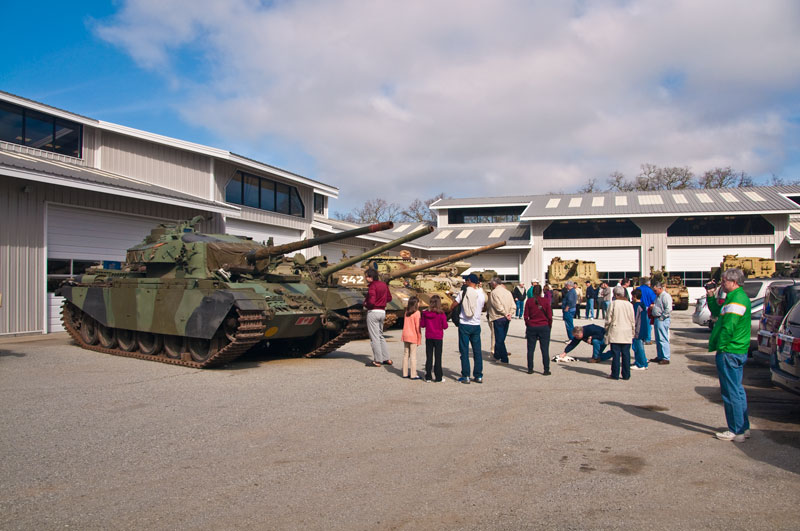
After meandering through the rolling hills of Portola Valley, we arrived at the museum. Here our group in February assembles in the courtyard between the three main display buildings that are arranged in a U. There is a fourth building behind me that contains the restoration facility and other vehicles that wouldn't fit elsewhere. Tours are given twice a day on Saturdays only to groups of ~30. Contact the MVTF directly through their website if you're interested in a tour: http://www.mvtf.org/pub_tours.php. Note the various military vehicles on display outside for there simply isn't room to display them all inside. Other vehicles in queue for restoration are behind these buildings. This is the February group waiting for the tour to begin.
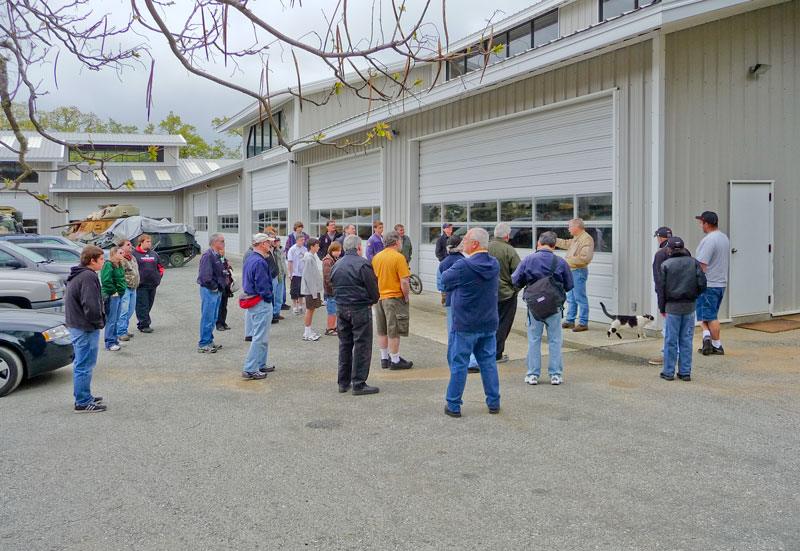
And here is the April group hearing introductory remarks by our docent, Michael Brandt, the same docent as we had in February. The tour begins through the door on the right into the first of the display buildings, i.e. the right side of the U. (Photo by Jon Miller.)
Note: Because of the large number of photos of military vehicles on this page, I've organized them by period and type of vehicle rather than by their location within the museum, i.e., the order in which they are encountered as one takes the tour.
Note: Also, frequent Home and Top-of-Page buttons allow the viewer to escape when they've had enough.
WW1 and Inter-War Tanks:
After entering the first building, we came upon two historically important tanks. On the right (below) is a US M1917 "Six Ton Tank", a copy of the French Renault FT Light Tank that first saw service in May of 1918 during WW1. This is the oldest vehicle in the collection. The Renault FT's major claim to fame is that it was the first production tank design with its armament in a fully rotating turret mounted on top, with the engine in back and the driver in front, a highly efficient layout that became a standard that remains today. The light tank battalion of the US Armor Corps of the American Expeditionary Force, commanded by Lt. Colonel George S. Patton of WW2 fame, employed the Renault tank. Only a few US M1917s arrived in France before the armistace and did not see action. The M1917 mounted either a .30 caliber machine gun or a 37mm gun and was designed for close infantry support. Weight was 6.5 metric tons or tonnes (1 tonne =1000 kg), a unit I use thoughout this page.
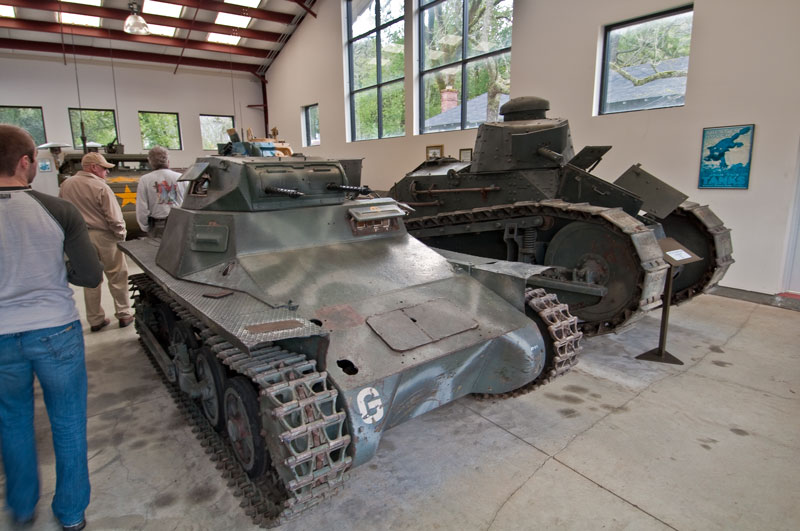
To the left is the German Panzerkampfwagen I (abbreviated PzKpfw I) Light Tank first manufactured in 1932 that first saw combat in the Spanish Civil War (1936-1939), and later in WW2 in Poland, France, the Soviet Union, and North Africa, though it was obsolete by that time. Armament was two 7.92mm machine guns, considered sufficient for its intended role of infantry support. Note the modest progress in tank design between the wars. The pace of development picked up dramatically during WW2 as seen in the following pictures. Weight 5.4 tonnes.
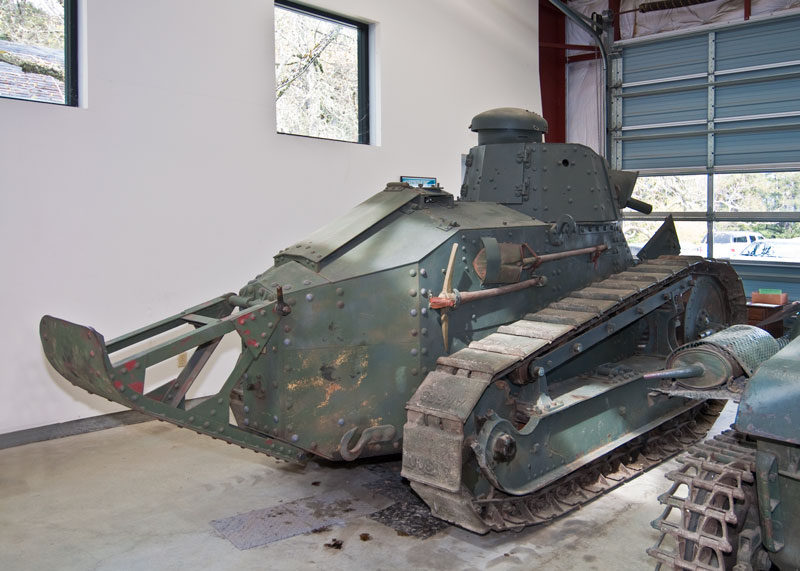
US M1917 Light Tank from the rear. Note the sled extension to improve its trench crossing capability.
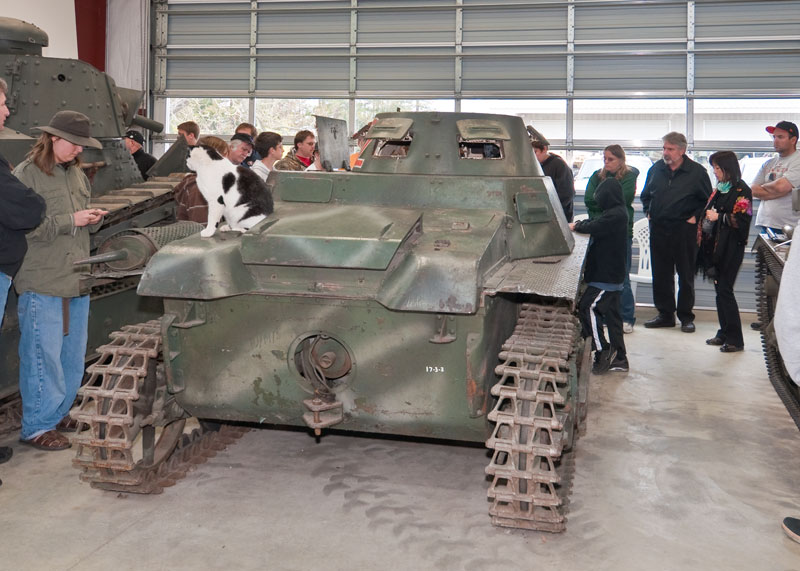
PzKpfw I Light Tank from the rear.
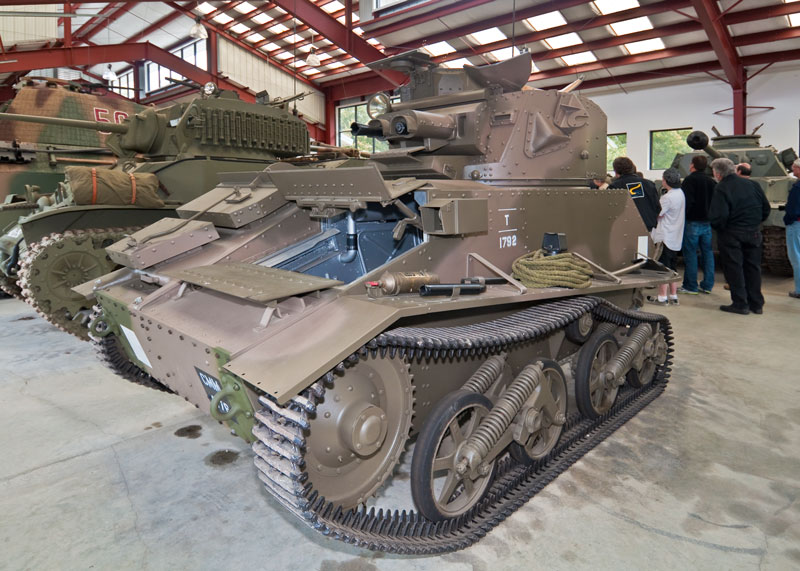
English Vickers Mk. VI Light Tank. Sixth in the series, the Mk. 6 was built from 1936 to 1940 and was used by the English Army until 1942 by which time it was obsolete and used for training only. However, in 1940, it was the most numerous tank of the British Expeditionary Force in France and in North Africa. It had a crew of 3, and its armament consisted of a water-cooled .303 and an air-cooled .50 Vickers machine gun. Weight was 4.9 tonnes.
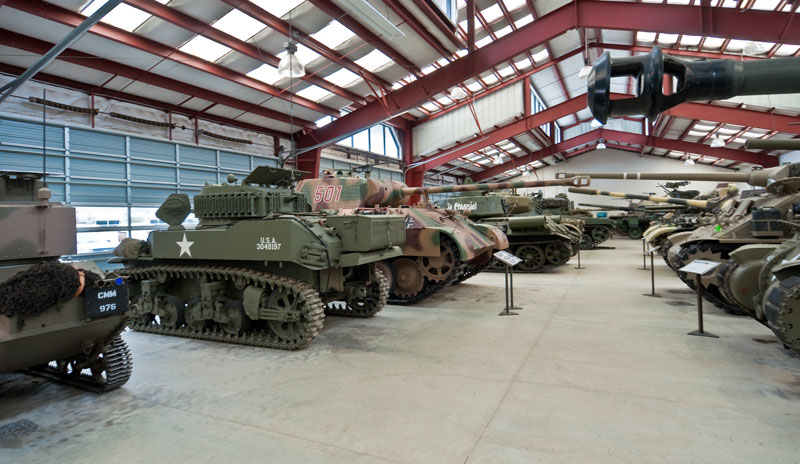
To give you some idea of the size of the collection, here's a photo that looks down the length of the first building, which is, by the way, the least crowded of the three main display buildings. I'm standing under the barrel of the German PzKpfw IV Ausf. G Medium Tank (photo below under WW2 Medium Tanks); the back of the English Vickers Mk. VI Light Tank (above) can just be seen on the extreme left. The British Matilda Mk II Series 4 Medium Tank (below) is behind me on the right, and the French M1917 Renault FT-17 and German Panzerkampfwagen I Light Tanks are out of sight on the left. Because of the cramped spacing between most of the vehicles I had to use a super-wide angle lens to photograph them, usually wide open at 12mm while standing only a few feet from the vehicle.
WW2 Light Tanks:
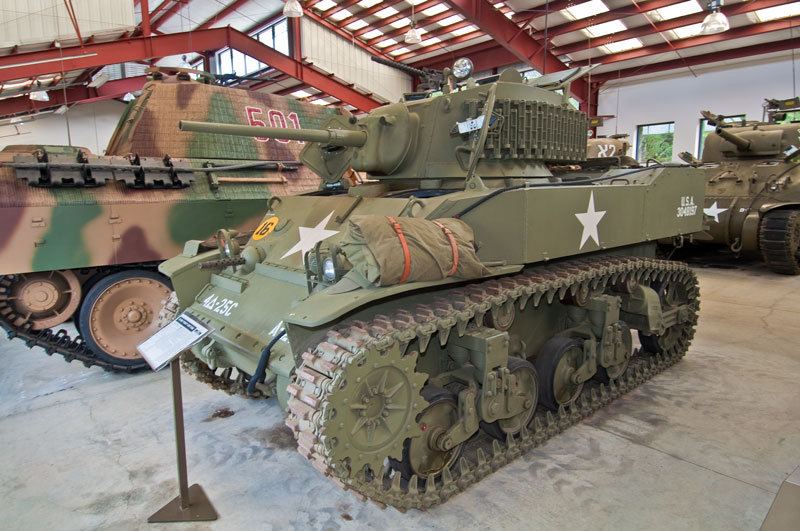
US M5A1 Stuart Light Tank. The M5A1 was introduced in late 1942 and saw service throughout WW2. Main armament was the high-velocity 37mm M6 gun (muzzle velocity 2,900 ft/sec when firing an armor-piercing round) that was also used as the army's primary towable anti-tank gun (Jeep towable) until the last year of the war. This improved version of the earlier M3 Stuart Light Tank had a redesigned hull with sloped glacis plate and twin Cadillac V-8 automobile engines that replaced the radial aero-engine of the earlier tank that was desperately needed for the M3 and M4 Medium Tanks. Outgunned by the larger German tanks, it was primarily used for reconnaissance in Europe. In the Pacific, it saw considerable action because the Japanese didn't field many tanks or have many effective anti-tank weapons. The name "Stuart" came from the British practice of naming American-built tanks after famous Civil War generals, which then found its way to common use in the US. It had a crew of 4. Weight was 17.7 tonnes.
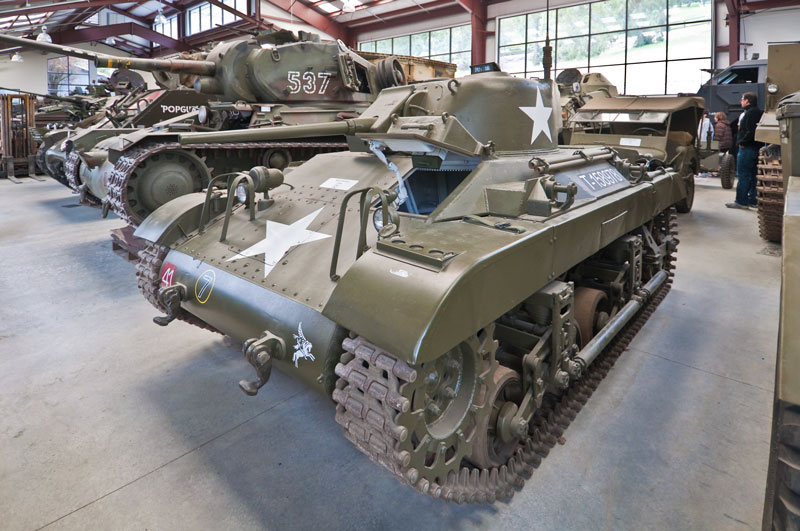
US M22 Locust Light Tank. Introduced in 1943, the M22 was designed at the request of the British War Office to be transported by glider to support their airborne troops. The M22 saw action briefly in March 1945, but proved mechanically unreliable and difficult to transport. Main armament was the same 37mm M6 gun as used on the M5 Light Tank (above). At just over 6 feet in height, you have to stand next to it to realize just how small it is. It had a crew of 3, and weighed 7.4 tonnes.
WW2 Medium Tanks
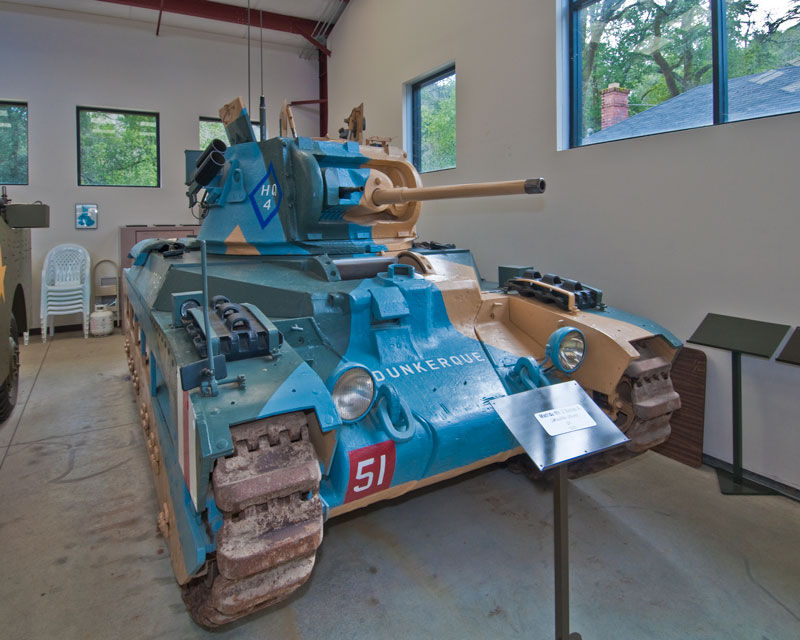
British Matilda Mk II Series 4 Medium Tank. The Matilda was first produced in 1937 and saw service throughout WW2. Main armament was a 2 pounder/40mm gun (muzzle velocity 2,600 ft/sec for AP round). It was designed to meet the English doctrine of infantry tanks, i.e. heavily-armored albeit slow-moving, to supply close infantry support. It proved highly effective early in the war due to its superior armor compared to the contemporary tanks of Germany and Italy. Later the larger-caliber higher-muzzle velocity guns of the new German Armored Fighting Vehicles (AFVs), e.g. Panther and Tiger tanks and various Jagdpanzers, and towed anti-tank weapons, proved very effective against it. Weight was 27 tonnes.
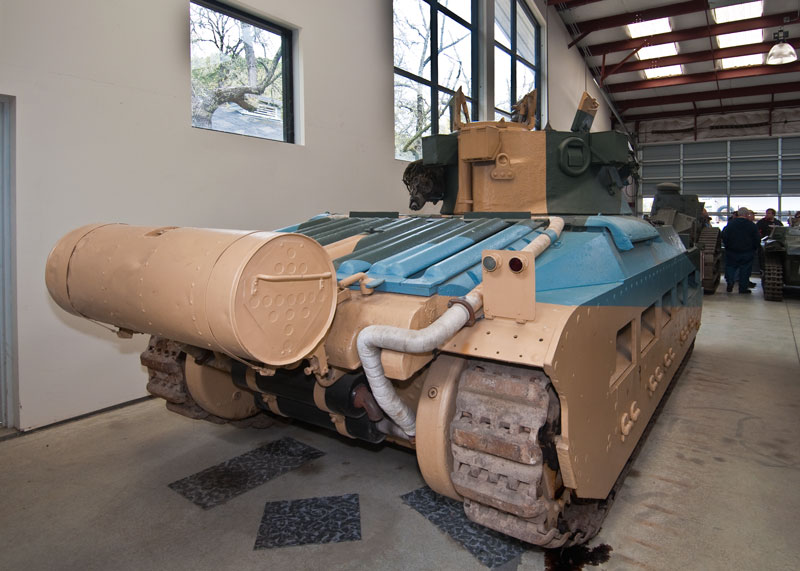
British Matilda Mk II Series 4 Medium Tank. Rear view.
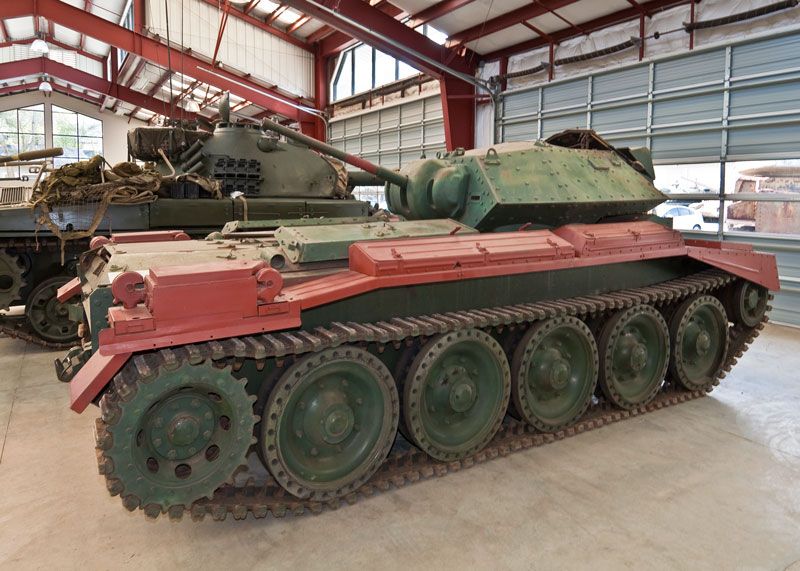
British Crusader Mk. II, side and rear with turret reversed. The Crusader was first introduced in 1941 and saw action in North Africa. It was a cruiser-type tank, i.e. fast but lighty armored (in contrast to the Matilda above) to allow rapid advance through enemy lines. However, this proved to be a liability against the superior armament of the German tanks, so it was largely supplanted in the cruiser tank role by the US M3 and M4 Medium Tanks as they became available through Lend Lease in the North African and Italian campaigns. Primary armament was the same 2 pounder/40mm gun used on the Matilda tank, as seen on the Crusader below. The 2 pounder was replaced in 1942 with a 6 pounder (57mm) gun. Weight was 19.3 tonnes.
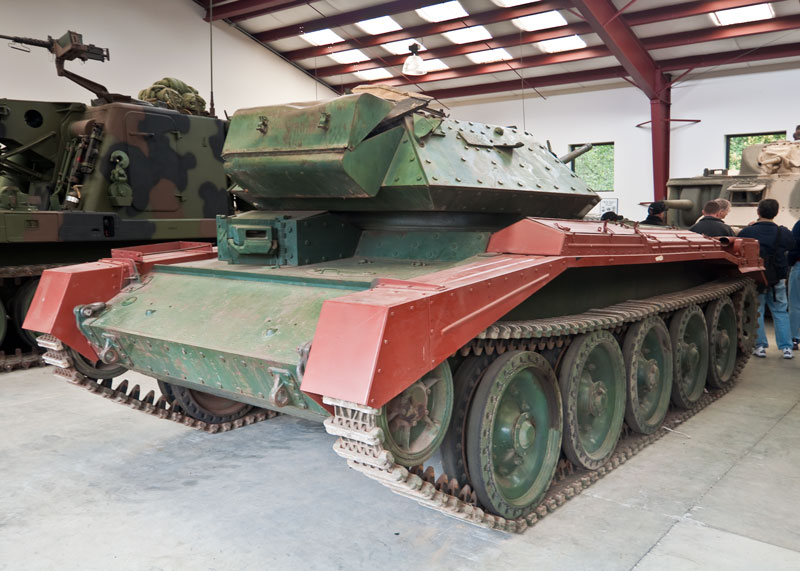
British Crusader Mk. II, front of tank.
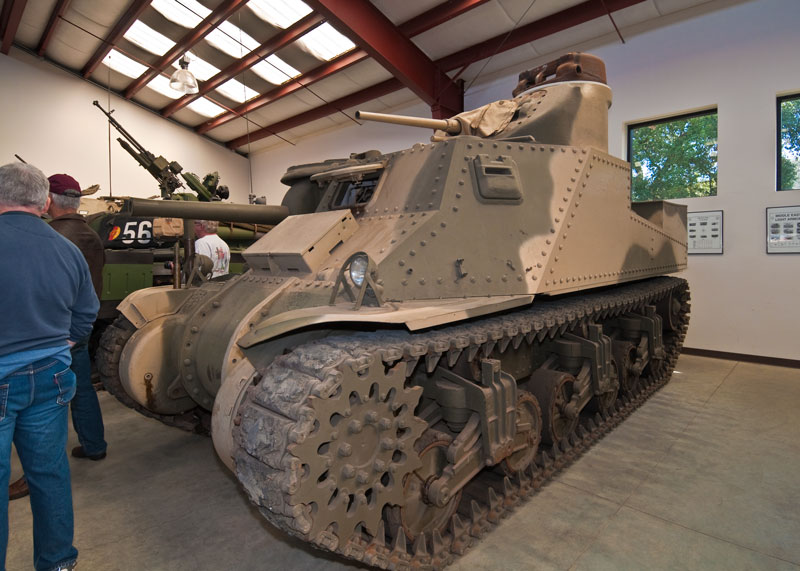
US M3 Lee I Medium Tank. The M3 was obsolete when it was first produced in 1941. It was seen from the outset as an interim solution until the M4 Sherman (below) could be delivered. The design was unusual in that the main gun, a 75mm M2 L/30 moderate-velocity gun (1,930 ft/sec), was mounted in a side sponson that allowed only limited traverse, and a higher-velocity 37mm M5 gun (~2,900 ft/sec) was mounted in a turrent on the top of the hull. In a cupola (rusting and unpainted in this example) atop the turret was mounted a redundant .30 caliber machine gun that gave the M3 a very high and ungainly profile. The British later redesigned the turrent to lower the tank profile and renamed it the M3 Grant. The M3 saw service in North Africa and Italy. It had a 7 man crew. Weight was 24 tonnes.
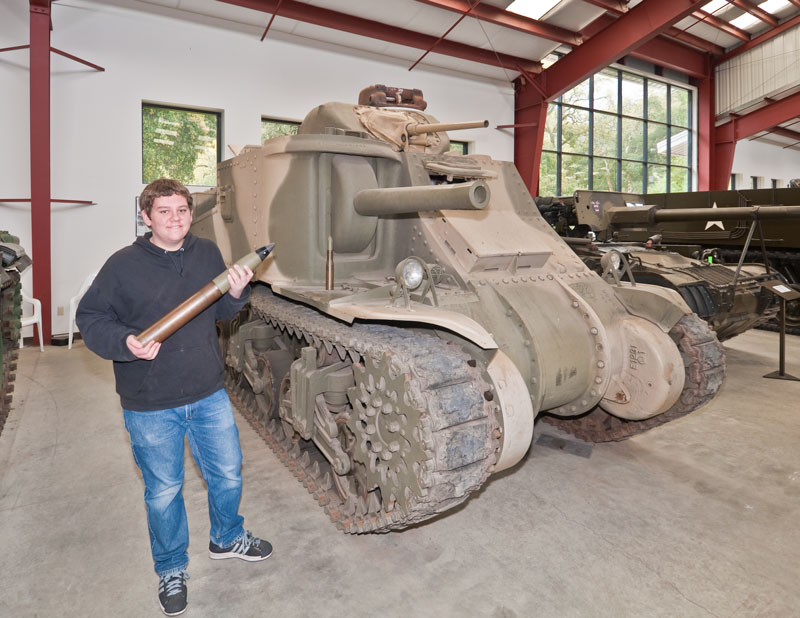
US M3 Lee I Medium Tank from its left side, more clearly showing its sponson-mounted 75mm gun. My nephew, Mark, is holding a 75mm round. The 37mm round fired by the gun in the turret-mounted gun, by way of comparison, stands just to the left of the main gun.
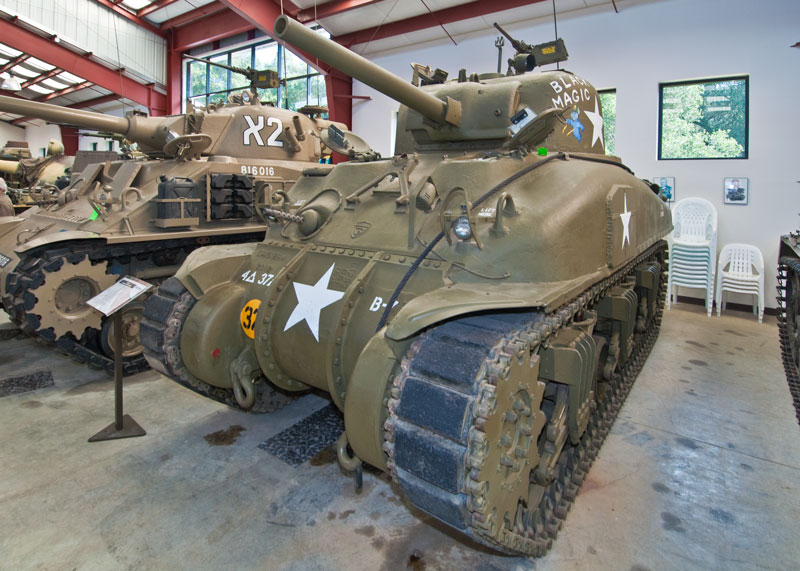
US M4A1 Sherman Medium Tank. The Sherman Tank was the primary tank used by the US throughout WW2 after its introduction in 1942, and was widely distributed to our allies by Lend Lease. The Sherman would later serve in armies all around the world through the 1990s. Over 50,000 Shermans were produced during the war, exceeded only by the Russian T-34 tank (below). Main armament was a longer version of the 75mm general-purpose gun from the M3 Medium Tank, the M3 L/40 (muzzle velocity 2,030 ft/sec). The Sherman was the equal of the German and Italian tanks it first faced in North Africa, but later proved to be under-armored and under-gunned compared to the more heavily armed and armored German tanks it encountered in Western Europe, e.g. the upgunned German PzKpfw IV, and the Panther and Tiger Tanks. Its major attribute was its incredible reliability. Note the applique armor welded to the right side, a field expediant to protect a vulnerable ammunition cache. The Germans became adept at using the star painted on it as a target. In the field, the crew would generally efface the star with mud or paint if they had it. Weight was 30 tonnes.
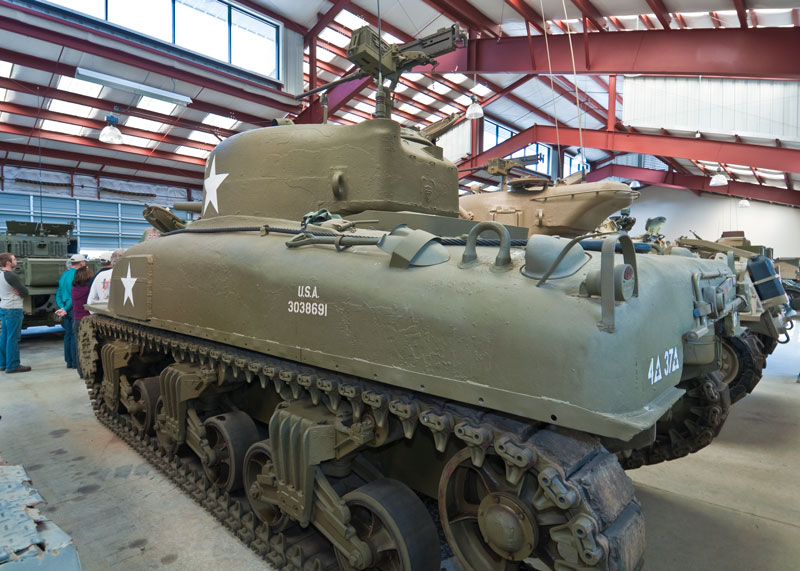
US M4A1 Sherman Medium Tank. Rear view.
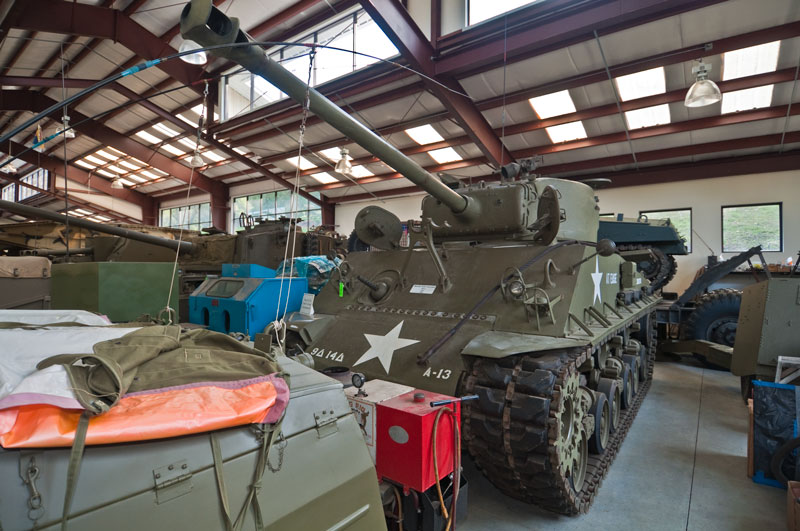
US M4A3E8 Sherman HVSS (Horizontal Volute Spring Suspension) Medium Tank with a 76mm gun. This was the final version of the Sherman Medium Tank during WW2. In 1944 the higher-velocity 76mm M1A1 gun was introduced that gave the Sherman armor-piercing firepower comparable to the Soviet 85mm ZiS-S53 gun (muzzle velocity ~2,600 ft/sec). Unfortunately, this was still insufficient to pierce the front armor of the German Panther and Tiger tanks. The HVSS suspension modifications were made to address the greater weight of the larger turret and 76mm gun, and to generally improve the ride of the tank. The hull was welded and the armor slightly thickened (in contrast to the cast hull of the M4A1 above). Weight was 33 tonnes.
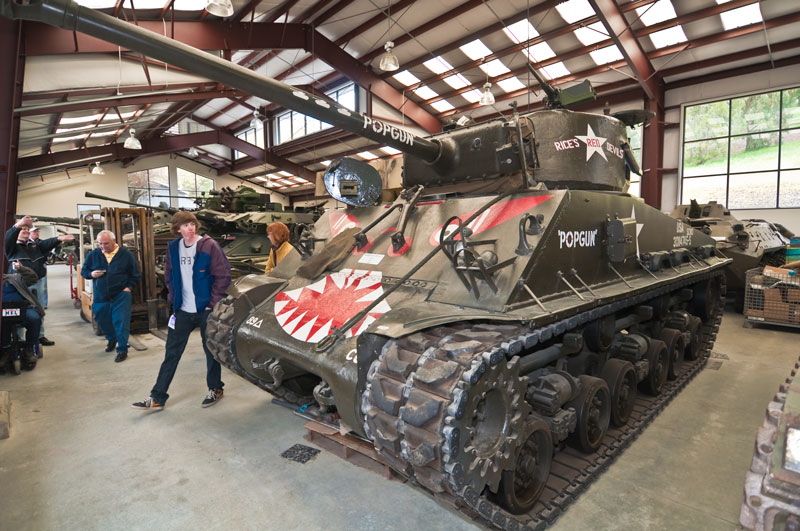
Another US M4A3E8 Sherman. Judging from its paint scheme, it must have served in the Pacific Theater.
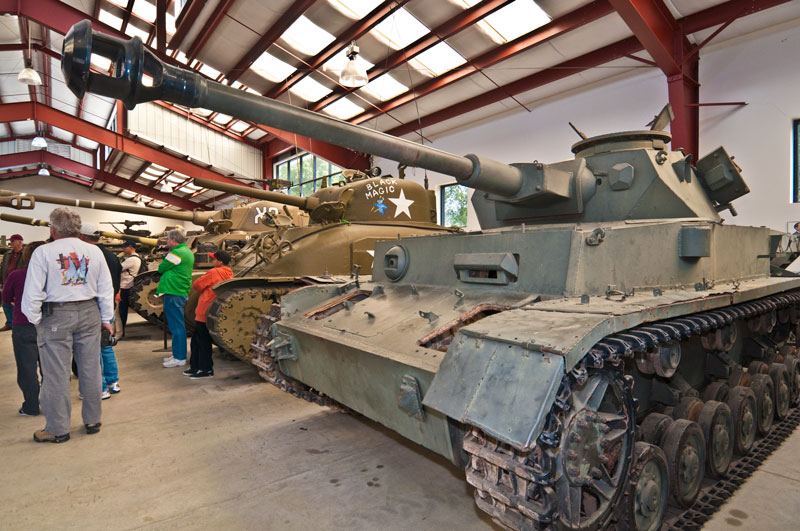
German PzKpfw IV Ausf. G Medium Tank. The PzKpwf IV, introduced in 1936, was the most widely deployed German tank of WW2. Robust and reliable and through many upgrades, it saw service in all combat theaters of Europe and North Africa. It's main armament was originally a short 75mm howitzer intended for infantry support that was later upgraded to a higher muzzle velocity 75mm KwK 40 L/48 gun (3,250 ft/sec when firing an armor piercing round) as seen on the Ausf. G in this image. This upgrade was necessitated by the superior armor of the British Matilda tank (above) and the Soviet T-34 tanks (below). Weight 24 tonnes.
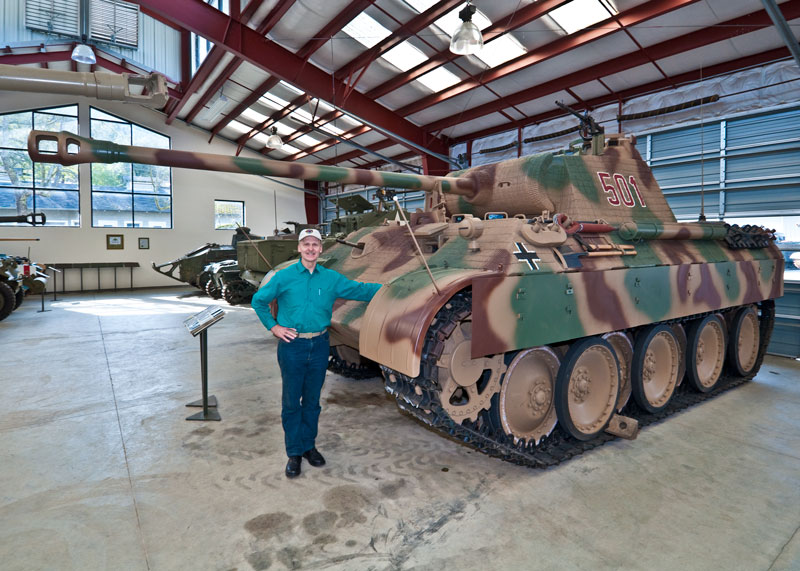
German PzKpfw V Panther Ausf. A Medium Tank. The PzKpfs V was introduced in 1943 to counter the Soviet T-34/76 (below) and served until the end of the war. Its combination of excellent firepower, mobility, and armor set a standard for tank design that lasted until after the war. Main armament was a high-velocity 75mm KwK 42/70 gun with an incredible muzzle velocity of 3,670 ft/sec, giving it armor penetration power greater than any other tank in WW2 until the Tiger 2 was introduced. Its major drawbacks were terrible reliability and difficult maintenance due to an overly complex design, which severely limited its affectiveness in combat. Weight was 45 tonnes.

German PzKpfw V Panther Ausf. A Medium Tank, rear view.
This PzKpfw V is perhaps the crown jewel of the collection at the MVTF, and was just recently restored to complete working condition in 2009 after sitting for 45+ years under the River Czarna Nida in Poland. It's restoration is documented in photos here: http://www.toadmanstankpictures.com/panther.htm, and in several videos on YouTube (search Jacques Littlefield Panther). Note the Zimmerit anti-magnetic mine coating that was applied to the outside of the armor. Jon Miller poses in front of the restored Panther tank. If a tank can be beautiful, it is this one. (I know. That's a guy thing.)
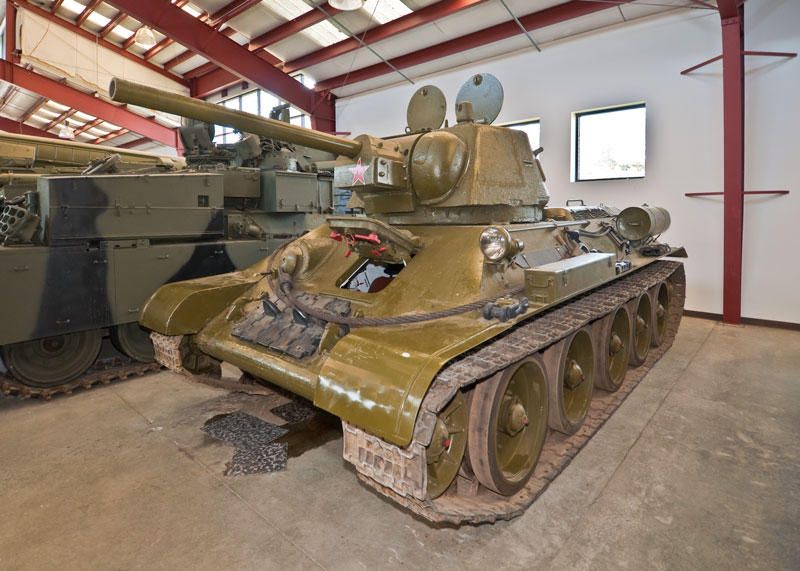
Soviet T-34/76 Medium Tank. This first version of the T-34, introduced in 1940, mounted a 76mm gun in a clumsy 2-man turret (the commander also served as the gunner). It was later upgraded to have a larger 3-man turret with an 85mm gun (below). However, this nimble tank with the 76mm F-34 gun (muzzle velocity 2,000 ft/sec) was very effective against the German PzKpfw I, II, III, and IV tanks that it first encountered in battle, giving the Germans quite a shock, which then drove them to develop more heavily armed and armored tanks, e.g. the PzKpfw V Panther (above). Weight was 26.5 tonnes.
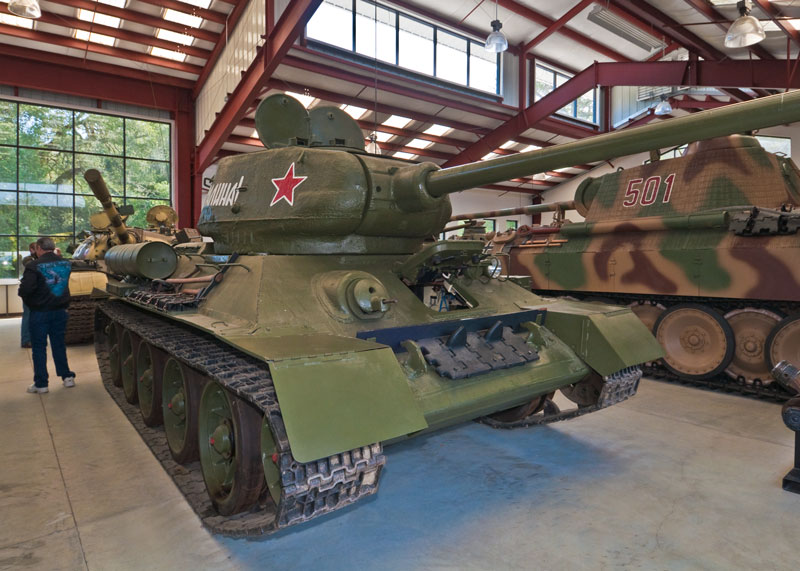
Soviet T-34/85 Medium Tank. The T34/85 was introduced in 1944 with a larger 85mm ZiS-S53 gun (muzzle velocity of 2,600 ft/sec) mounted in an up-armored 3-man turret to replace the older T-34/76 and to counter the larger armament of the German tanks. Many believe the T-34 to be the most effective and influential tank design of WW2. The T34/85 gave the Soviets a weapon that was superior to all German tanks but for the Panther medium and Tiger heavy tanks, and in much greater numbers and with greater reliability. Approximately 84,000 T-34s of both models were produced during WW2. Weight was 32 tonnes.
WW2 Heavy Tanks
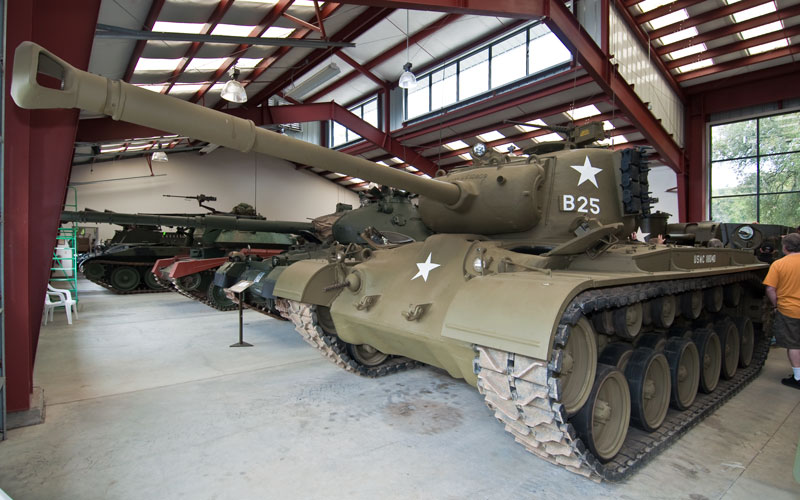
US M26A1 Pershing Heavy Tank, named after "Black Jack" Pershing of WWI fame, was developed to supply the US army with a tank of sufficient firepower and armor to be able to stand up to the German Panther and Tiger tanks. Unfortunately, disagreement on the tank specifications (mainly the caliber of the main gun) by the army leadership delayed delivery so that the first M26 tanks did not enter combat until Feb. 1945 just prior to the end of the war in Europe. Later it did see considerable action in Korea along with its successor the M46, that had an increased horsepower engine; the M26 was considered underpowered since it used the same engine as the M4 Sherman though weighing 12 tonnes more. Main armament of the M26 was the 90mm M3 L/53 gun (muzzle velocity of 2,700 ft/sec) and it had a 5 man crew. Note the torsion bar suspension that replaced the dual-wheel bogies of the M4 Sherman. Weight was 42 tonnes.
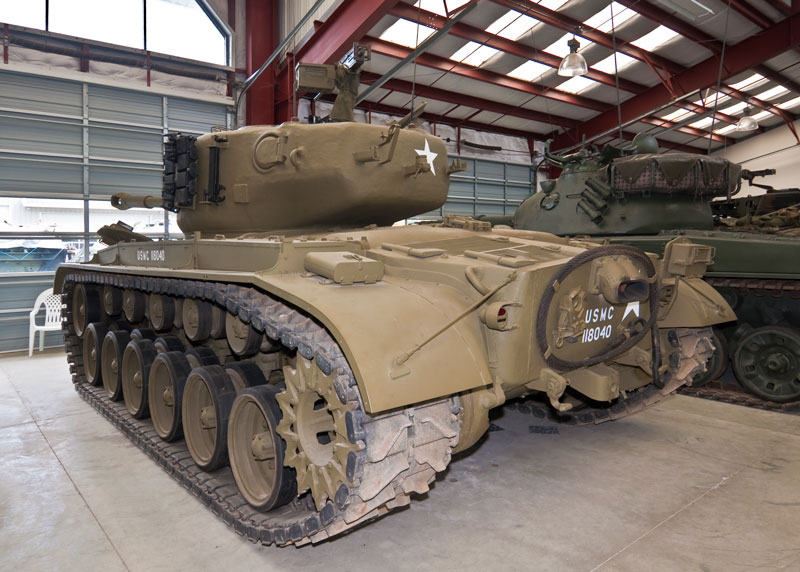
US M26 Pershing from the rear.
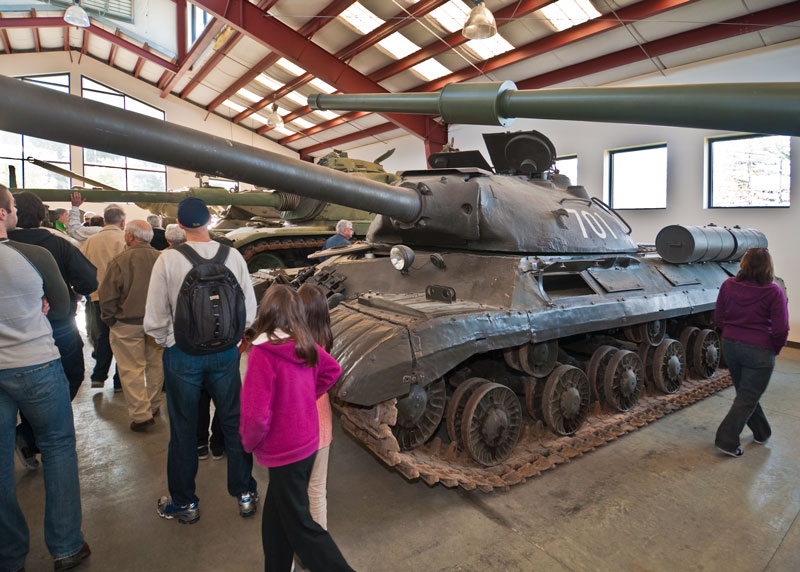
Soviet IS-3 Joseph Stalin Heavy Tank. The Stalin was first introduced into combat in April of 1944 to spearhead the Battle for Berlin in the final year of the war. It mounted a massive 122mm D25-T gun (muzzle velocity 2,640 ft/sec) that could penetrate the front armor of the German Panther tank but could also fire a large high explosive shell for anti-personnel combat. Tactically, it was used as a breakthrough tank, for infantry support, and to shell fortifications. The IS-3 model, introduced at the end of the war, is shown here. It is characterized by the hemispherical low-profile cast turret that is still the hallmark of modern Russian tanks (see T-55 and T-62 below). Note how the turret smoothly merges into hull eliminating shot traps at its base. Also note the external fuel tanks on the sides of the hull. Crew of 4. Weight was 46 tonnes.
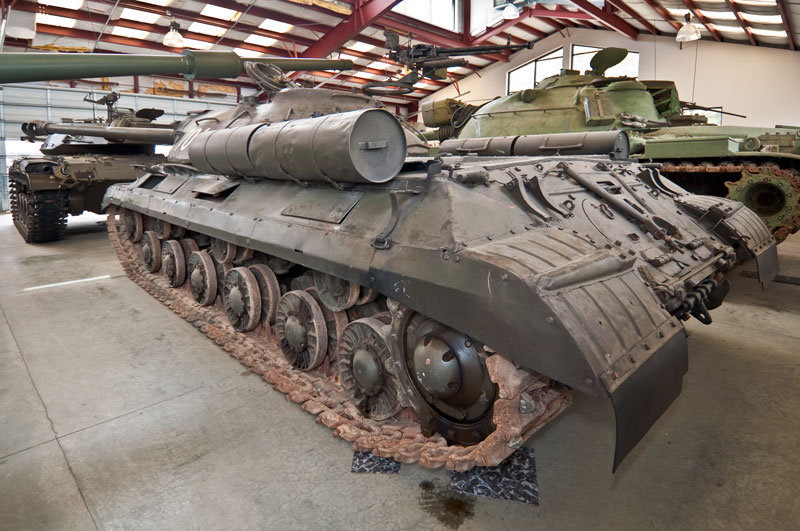
Soviet Joseph Stalin IS-3 Heavy Tank, rear view.
WW2 Mobile Artillery and Tank Destroyers
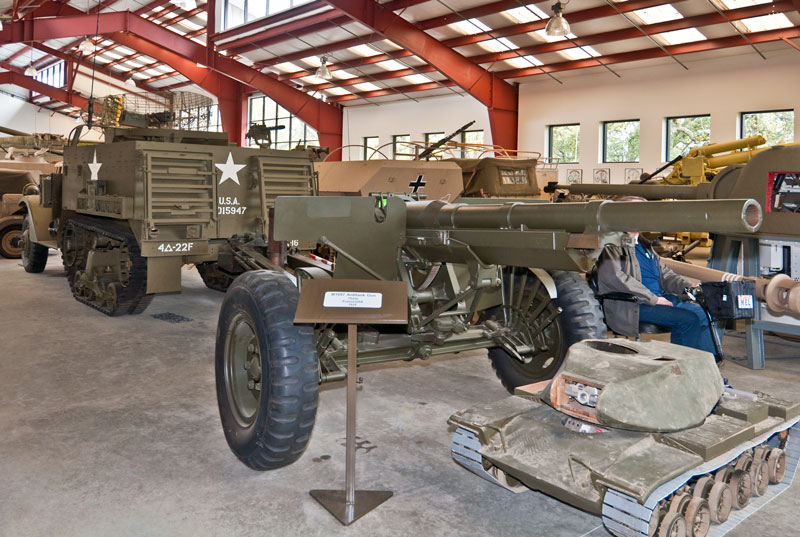
US M1897 75mm Howitzer and US M2A1 Prime Mover. A US copy of the French 75mm howitzer, this gun was used by the US Army in both WW1 and WW2, and was its primary light artillary piece.

US M2A1 Prime Mover. The M2 Half Track was designed for pulling various howitzer and anti-tank guns. The M2 Prime Mover was introduced in 1941 and saw action in the Philippines, North Africa and Europe. Armament was a .50 M2 Browning machine gun. Weight was 9 tonnes.
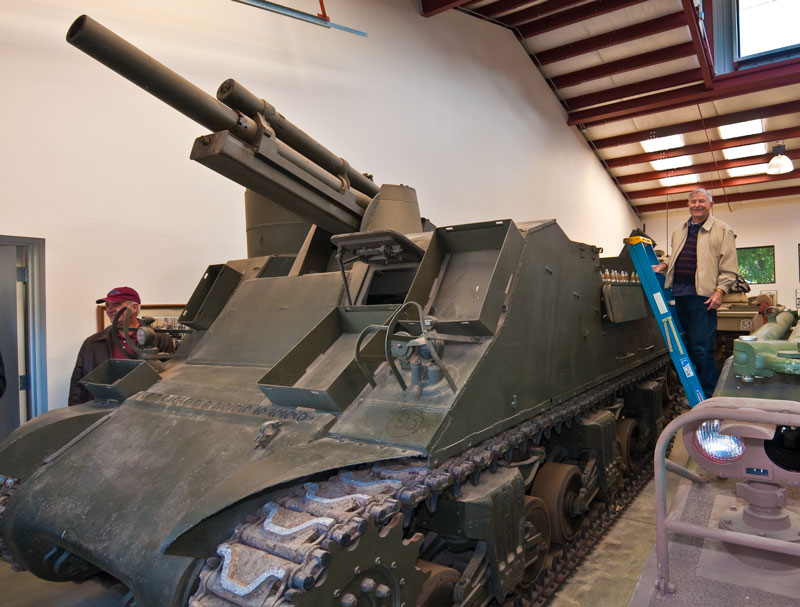
US M7B1 Priest Howitzer Motor Carriage (HMC). The M7 was first produced in 1942 to supply mobile artillery support to tanks and infantry. Main armament was a 105mm howitzer. The chassis was from the M4 Sherman. This is the tank my father commanded during WW2. He is standing on the ladder to the right trying to decide if he wants to climb in. The British gave this tank the name Priest due to the pulpit-like .50 caliber machine gun mount to the left of the howitzer (partially obscured by the howitzer barrel in this image). The M7 was considered a great success and was used by both the US and British armies. Each US armored division had three battalions of M7s, giving them unrivaled mobile artillery support. The M7 had a crew of 7. Its weight was 23 tonnes.

US M7 HMC, rear view. Note the "pulpit" .50 caliber machine gun ring just to the right of the howitzer.
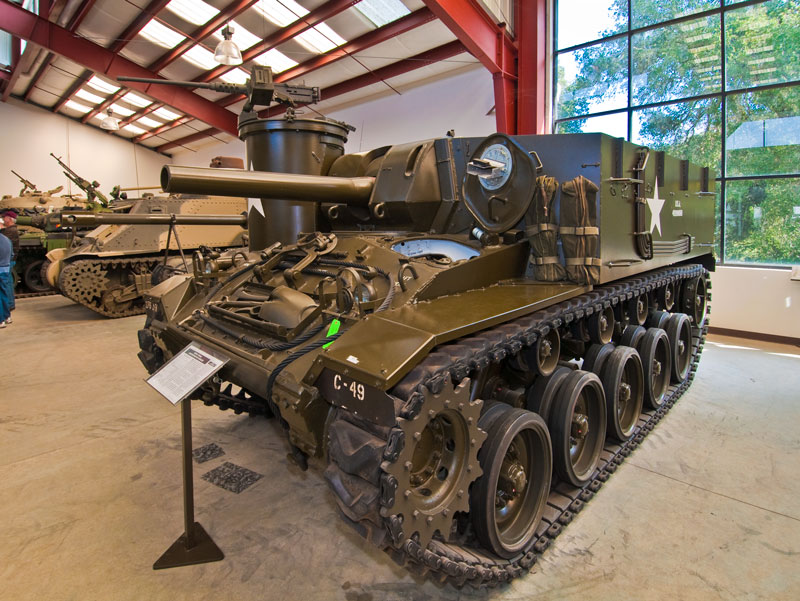
US M37 HMC. The M37 was introduced in 1945 at the end of WW2. Its main armament was the same 105mm howitzer as on the M7, but the chassis was from the M24 Chaffee Light Tank, which gave it greater mobility. Weight was 18 tonnes.
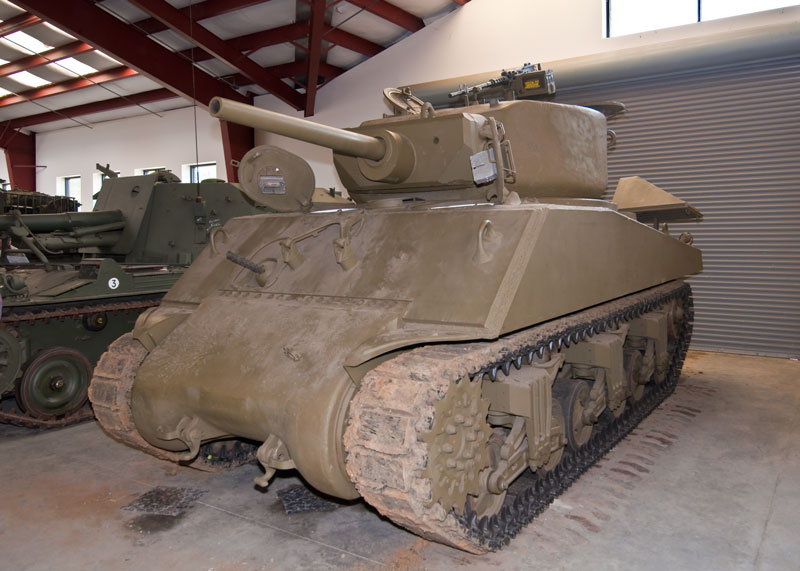
M4A3E2 Assault Tank, also known as the Jumbo Sherman. Introduced in June 1944, these Shermans had very thick armor, 1.5" applique armor added to the front glacis plate and the sides (on top of the 2.5" glacis plate of the standard Sherman), and a 75mm M3 L/40 or 76mm M1 gun in the new T23-style turret (6" of armor in the front and on the gun mantlet). They were primarily used for fortification assault and to lead a tank column when travel was restricted to roads. The front armor was thick enough to withstand a direct hit from the German Panther 75mm gun. Mobility was somewhat reduced, but the extra armor more than compensated and these tanks were very popular with their crews. Weight was 36 tonnes.
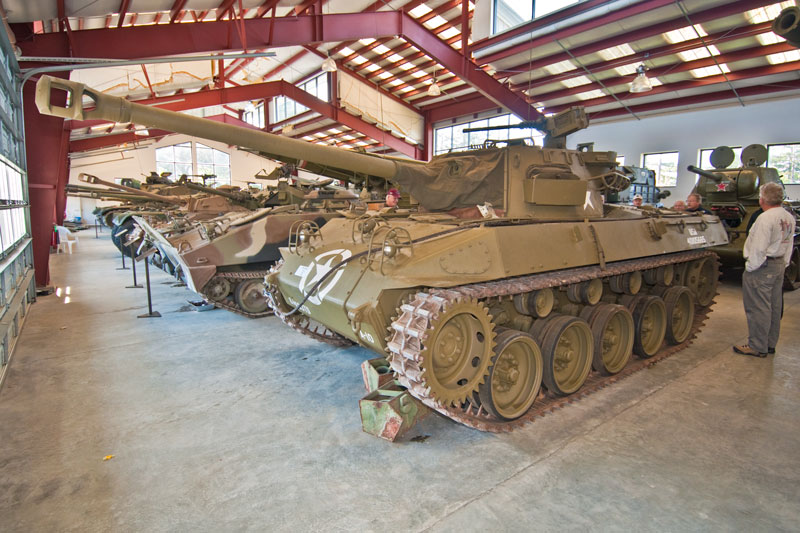
US M18 Hellcat Tank Destoyer (officially a Gun Motor Carriage or GMC). The M18 was introduced in 1943 to supply an urgent need for a fast tank destroyer and it saw action through the rest of the war. It's main armament was the same 76mm M1A1 gun that was used to upgrade the M4 Sherman tank (see the M4A3 Sherman below) mounted in an open turret. With its light weight (17.7 tonnes) and torsion bar suspension, the M18 could reach 60 mph on level terrain. It's main issue, common to most tank destroyers, was its very thin armor, and it had a relatively weak gun that could not penetrate the front armor of the German Panther or Tiger tanks except at very short ranges. (By the way, wer're looking down the length of the third display building of the U.)
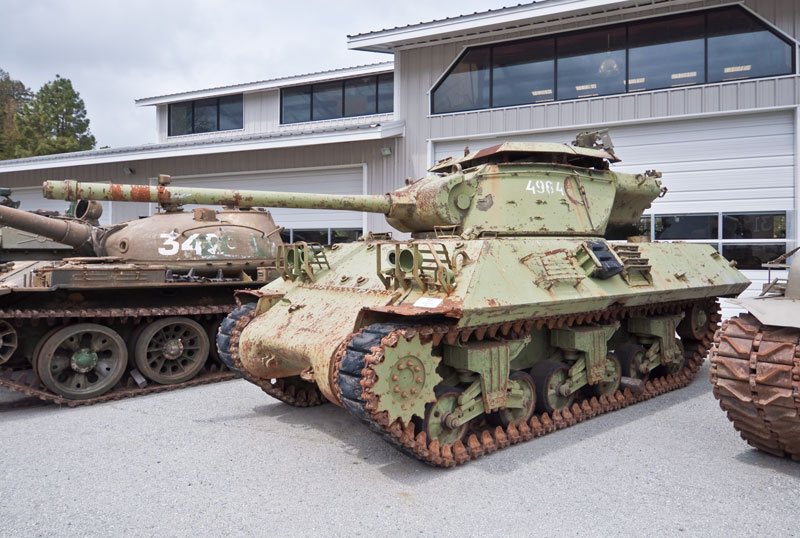
US M36B2 Tank Destroyer (GMC). The M36 was first introduced into combat in September 1944. Mounting the 90mm M3 L/53 gun (that would also be used in the M26 Pershing tank), it was the only US armored vehicle that could destroy a German Panther or Tiger tank at normal combat ranges. Like the M18, the turret was open-topped to save weight. After the war, a foldable armored roof was designed to protect the crew from shell fragments. The M36 also served in the US Army during the Korean War, and was exported to many countries, including Yugoslavia (as in this example below) who used it during the Croatian War of Independence (1991-1995). The M36B2 used the chassis of the Sherman M4A2 (diesel engine, VVSS suspension). It had a crew of 5 and weighed 29 tonnes.
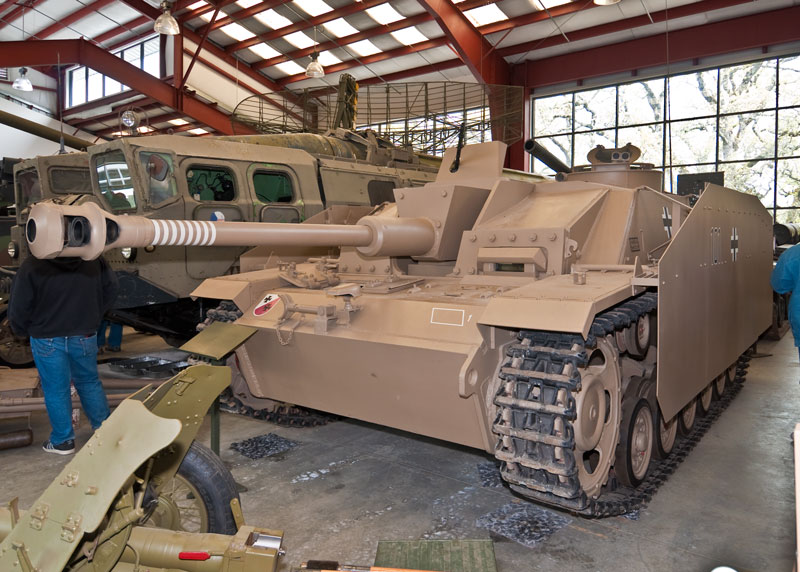
German Sturmgeschütz III (StuG III) Ausf. G Assault Gun & Tank Destroyer. The StuG III was Germany's most produced armored fighting vehicle of WW2, and served from 1940 to the end of the war. Early versions mounted the short-barreled 75 mm StuK 37 L/24 cannon intended for soft targets. Later versions were upgunned to the 75 mm KwK 40 L/48 rifle (same as the PzKpwf IV above) to serve as a mobile anti-tank weapon. The StuG III used the chassis of the PzKpwf III. It had a crew of 4 and weighed 24 tonnes.
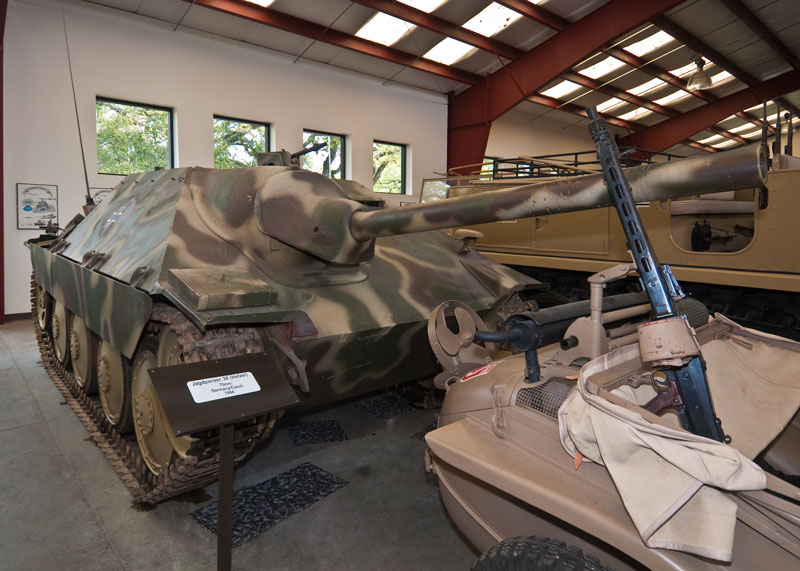
German/Czech Jagdpanzer 38(t) "Hetzer" Light Tank Destroyer. The Jagdpanzer 38 was derived from the pre-war Czechoslovakian 38(t) tank chassis, and saw service from 1944 to the end of the war. Its main armament was the 75mm Pak 39 (L/48) gun (muzzle velocity of 2,460 ft/sec firing an armor piercing shell). The sloped armor protection was excellent (120mm equivalent at the front glacis) as was the vehicle reliability since it was based on a proven tank design. It was also relatively small and easily hidden. On the hand, its gun had very poor traverse that often required the vehicle to be moved to track a target, and its interior was cramped, both of which negatively affected the performance of its 4 man crew. Weight was 16 tonnes.
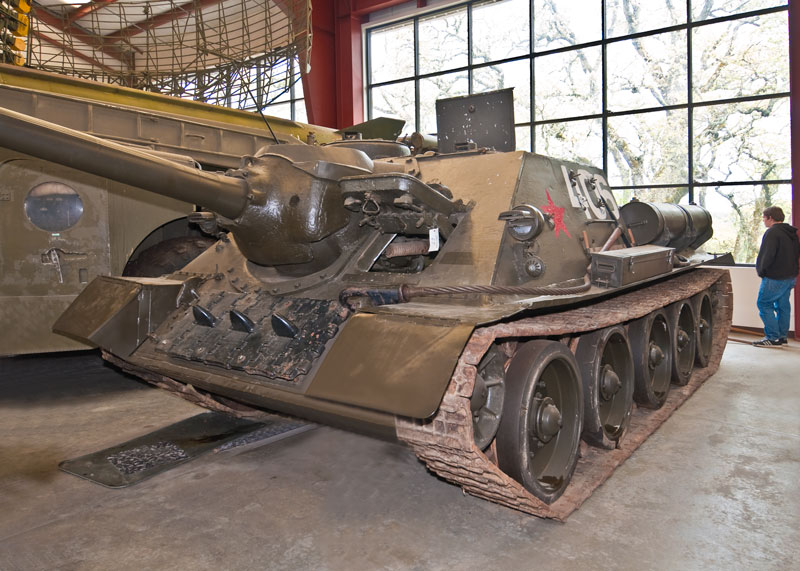
Soviet SU-100 Tank Destroyer. The SU-100 was developed in early 1944, built on the same chassis as the T34/85, and production began in Sept. 1944. It mounted a 100mm D-10 L/54 gun (muzzle velocity of ~3,300 ft/sec firing an armor piercing shell) that could penetrate the front armor of both the Panther and Tiger tanks at normal combat ranges, and that could also fire a large HE shell for soft targets. The SU-100 served through the end of the war and production continued through 1947. It was removed from service in the Soviet Union in 1957 but continues to be used in many nations today. The SU-100 had a crew of 4, and weighed 32 tonnes.
Intermission:
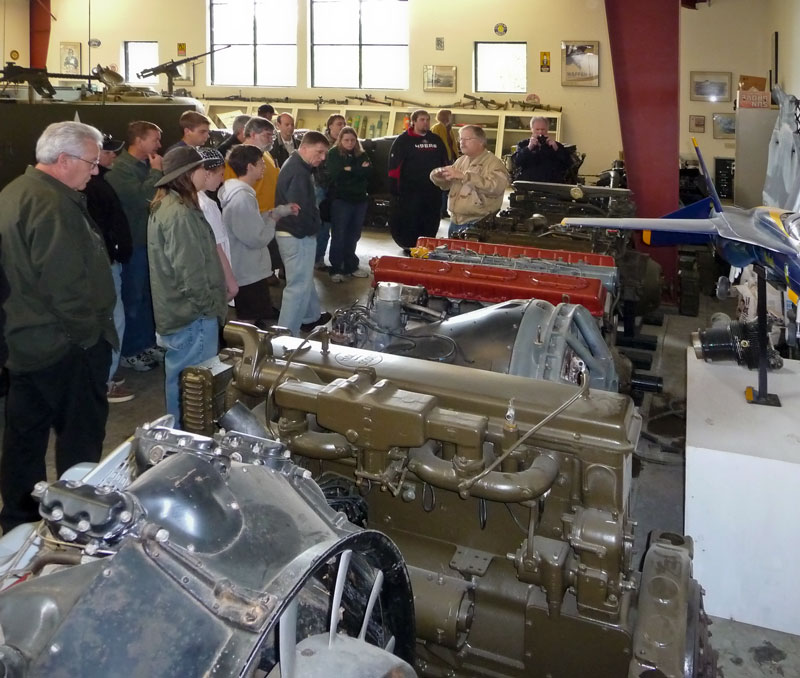
Here Michael Brandt discusses their fine display of military vehicle engines in the second of the display buildings. Against the far wall is a display of munitions and hand-held anti-tank weapons, e.g. the bazooka and the panzerfaust. (Photo by Jon Miller.)
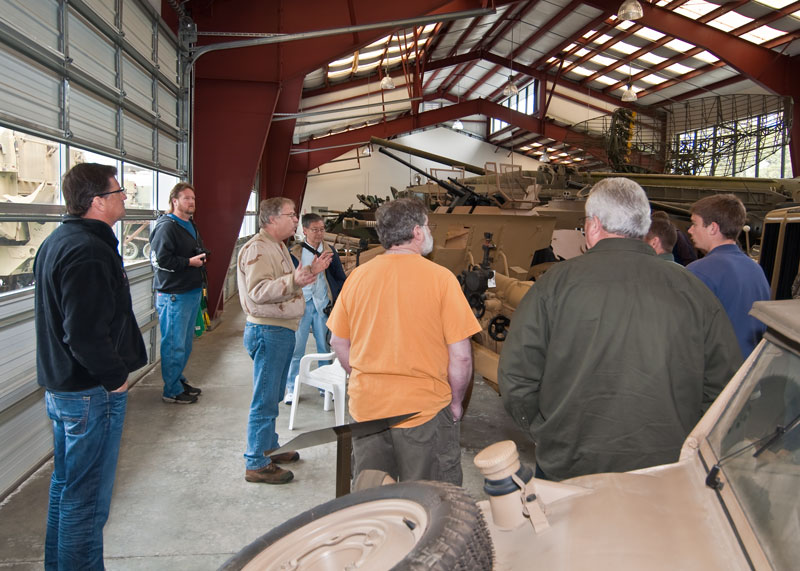
Here I'm shooting down the length of the second display building at the base of the U and the density of vehicles is increasing. The above display of engines and munitions is behind me.
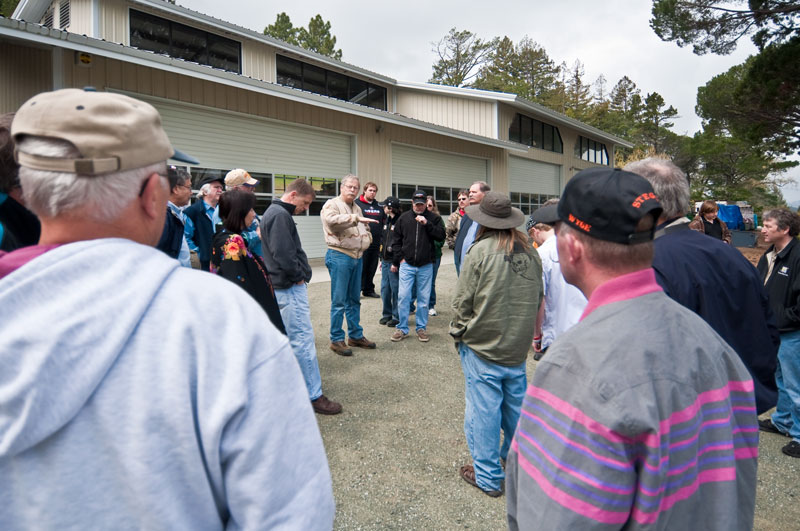
Michael Brandt addresses our tour group in front of the fourth building, now converted for display and storage, about the MVTF museum history. He's a very knowledgeable and an experienced instructor. I highly recommend him if you're planning your own tour of the MTVF.

Here's a view of the fourth building. The density of vehicles here made it almost impossible to walk around and my wide angle lens wide open at 12mm focal length was often inadequate.
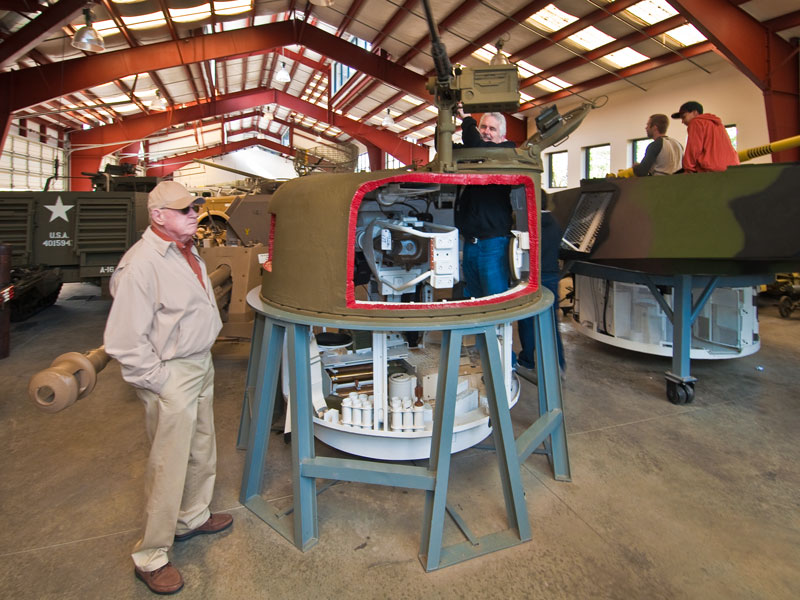
In the foreground is an M4 Sherman turret, partially cut away, that was used for training. Note how cramped it is. With a full crew of 5 during combat, 3 would have been in the turret: the commander, the gunner and the loader. To the right and behind the M4 turret, is an M1 Abrams training turret (not armored). Boys of all ages can be seen having fun.
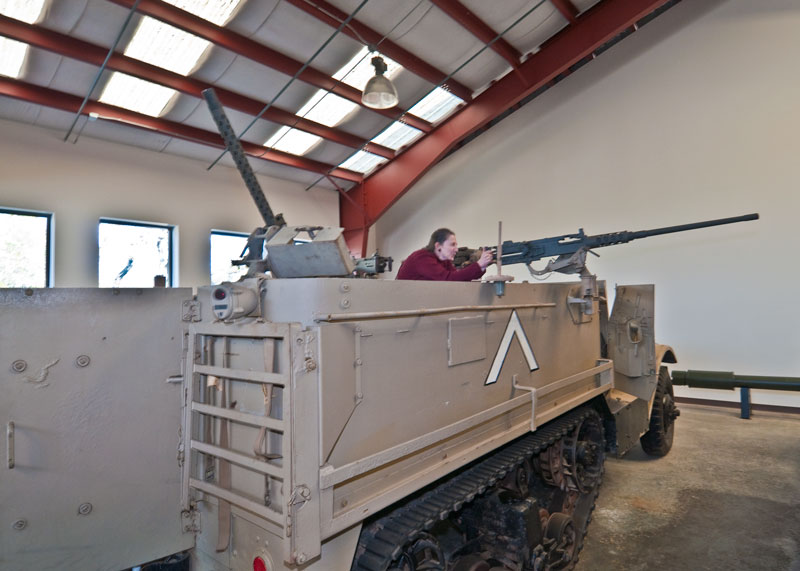
Guests are not normally allowed to climb on the military vehicles at the MVTF, but we were encouraged to climb into this Israeli half track to try out the .50 caliber machine guns. Denise takes her turn here.
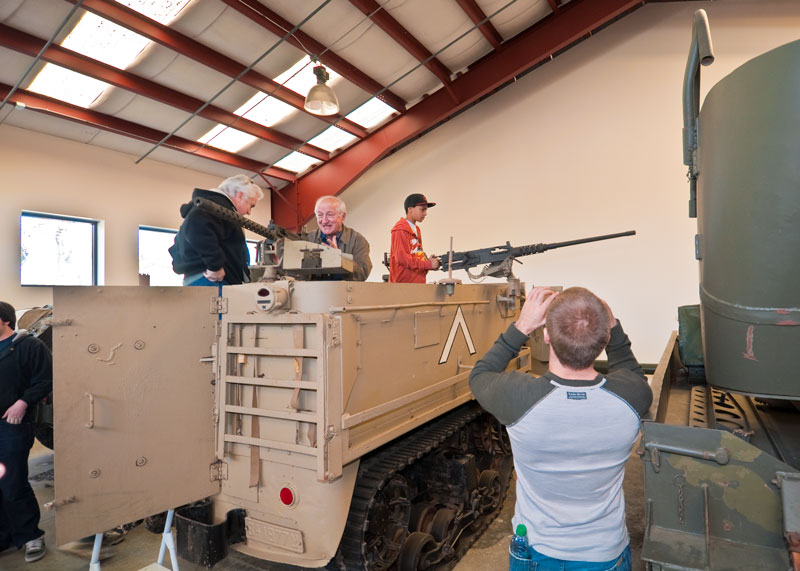
And here, again, boys of all ages got to play.
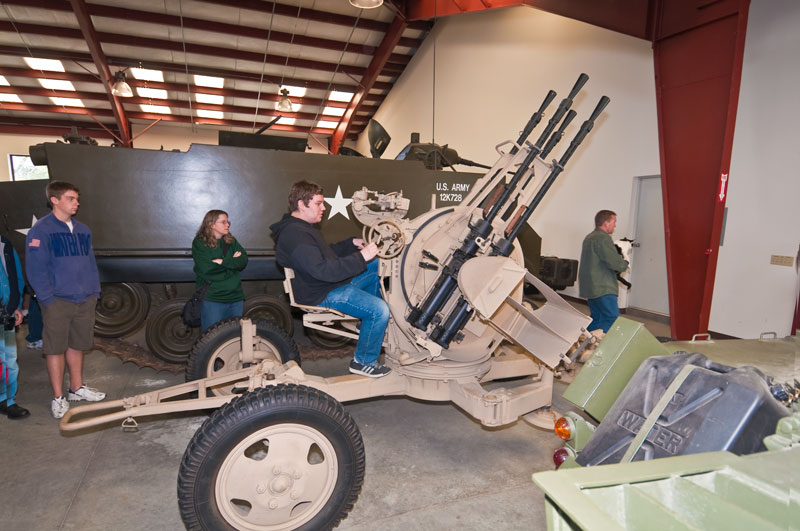
Soviet ZPU-4 Quad-Barreled Anti-Aircraft Gun. The ZPU-4 was introduced into service in 1949, and serves in the armed forces of many nations today. It mounts four 14.5mm Vladimirov (KPV) heavy machine guns. Firing an API (BS 41) projectile, weighing 64.4 grams, at about 3,300 ft/sec, it is able to penetrate more than an inch of armor of a low-flying target such as a helicopter. Here my nephew, Mark, gets to play a bit.
Post WW2 Armored Vehicles:
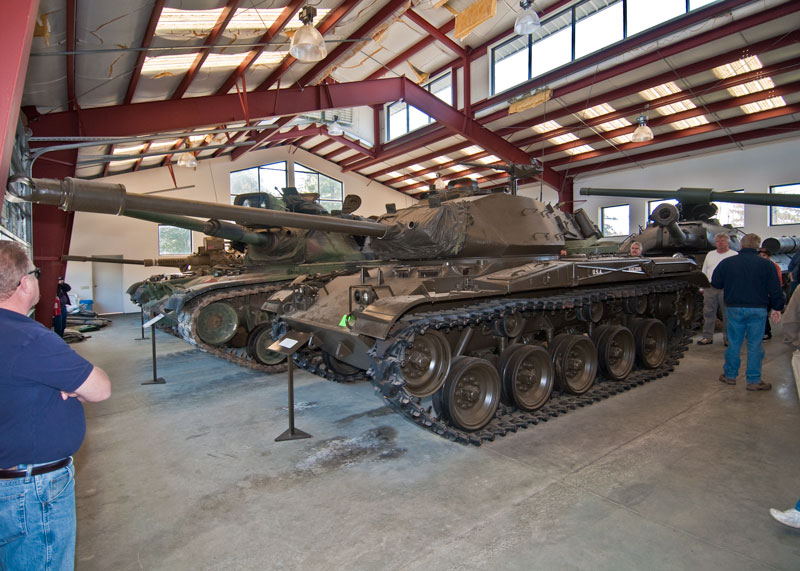
US M41 Walker Bulldog Light Tank. Introduced in 1951, the M41 saw action in Korea and Vietnam. The M41 replaced the M24 Chaffee Light Tank (that had replaced the M5A1 Stuart - photo above) that had proved to be too lightly armed for combat in Korea. Main armament of the M41 was a high velocity 76mm M32 gun (muzzle velocity 3,200 ft/sec). Weight was 21.4 tonnes.
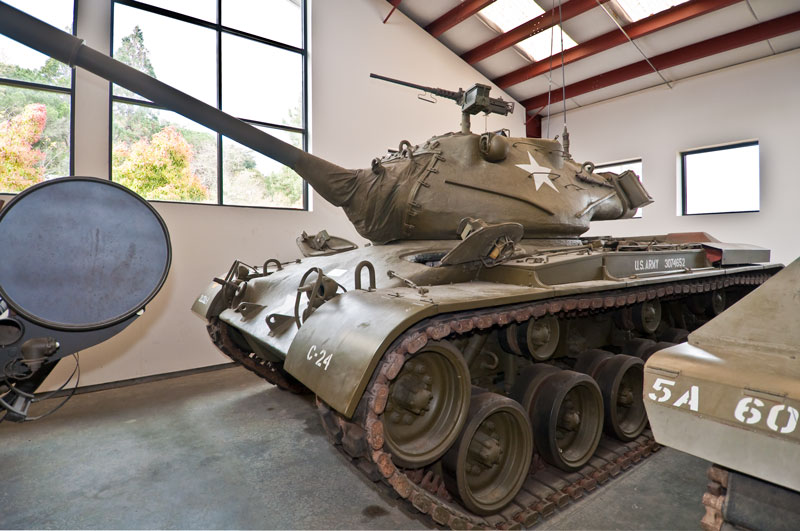
US M47 Patton Medium Tank. Developed from the M26 and M46 tanks, and redesignated as a medium tank, the M47 entered service in 1952 but arrived too late to see any action during the Korean War. Its main armament was a 90mm M36 gun (muzzle velocity of 3,200 ft/sec) and it had a 5 man crew. The M47 design was considered a stopgap solution to provide a tank that could counter the Warsaw Pact heavy tanks. It was soon replaced by the much improved M48 Patton medium tank in 1953 that included a redesigned turret among other significant changes. The M47 remained in service with the Marine Corps until 1959. Weight was 46 tonnes.
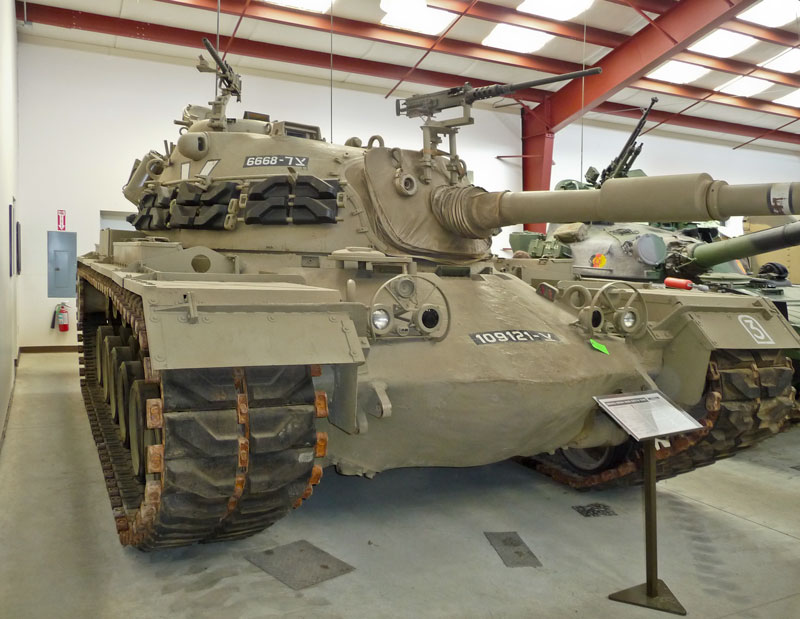
US M48A4 Patton Medium Tank. The M48 was developed in an accelerated program during the Korean War and first deliveries were made in 1952. Standardization of the M48 design didn't occur until 1953 due to the many defects discovered in the early vehicles. The M48A3(90mm) did see extensive service in the Viet Nam, the Middle Eastern and Indo-Pakistani wars. The M48 was first armed with the 90mm M41 L/48 gun (4,050 ft/sec with HVAP round). Later a 105mm M68 L/52 gun (4,360 ft/sec with a HEAT round) was mounted in an M60 turret on the M48A3/A4 models, such as this Israeli version below. Superficially the M48 resembled the M47, but was a completely new design: turret, hull and suspension. It had a crew of 4. Weight was 45 tonnes. (Photo by Jon Miller.)
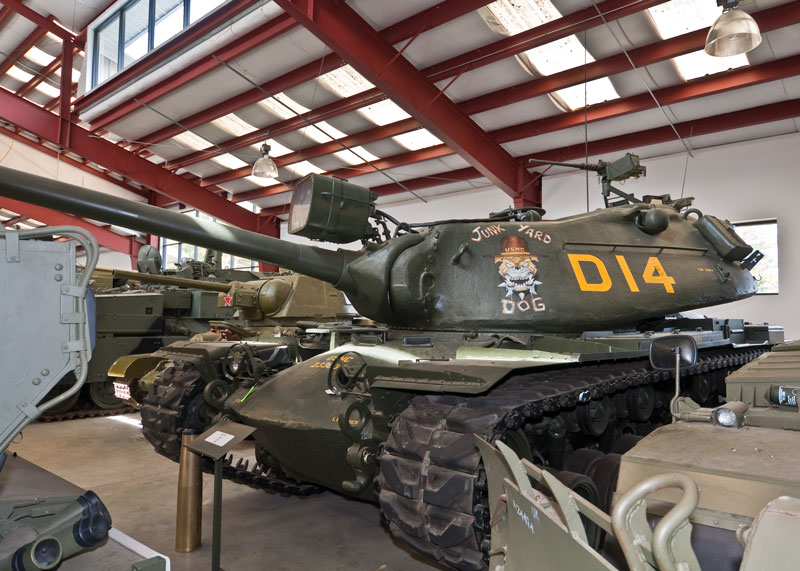
US M103A2 Heavy Tank. The M103 was developed to counter the Soviet heavy tanks of the early Cold War. Until the introduction of the M1 Abrams Main Battle Tank (MBT), it was the heaviest and most heavily-armed tank developed for the US Armed Forces. First deliveries were made in 1957 to both the US Army and to the US Marine Corps. Due to the M103's extreme weight and large size that made it extremely difficult to deploy, it was quickly replaced by the M60 Main Battle in the Army (1960) and later in the Marine Corps (1973). Acceptance of the M60 MBT ended the doctrine of separate medium and heavy tanks in the US Armed Services. The M103 mounted a 120mm M58 rifled gun (in contrast to the 120mm smooth bore of the M1 Abrams MBT). It had a crew of 5, 4 of which were stationed in the large turret: commander, gunner, and two loaders due to the heavy weight of the rounds. The M103A2, shown below, was developed in 1964 for the Marine Corps by the addition of the M60's 750 bhp diesel engine and an improved sighting system. Weight was 58 tonnes.

US M103A2 Heavy Tank. Rear view.
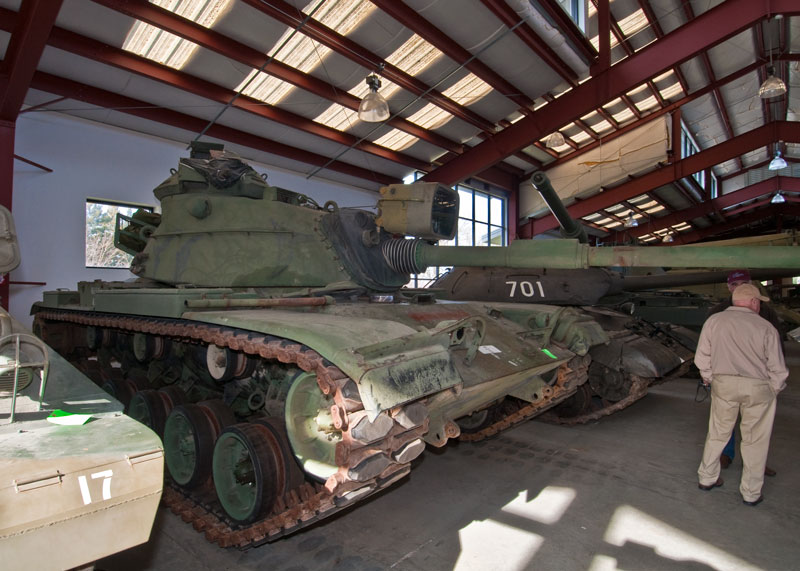
US M60A1 MBT (Main Battle Tank). The M60 was the first-generation US MBT (though some argue that that honor belongs to the M46/47/48 series of tanks), ultimately replacing the M48 medium and the M103 heavy tanks. The MBT concept was that a modern medium tank could carry guns of sufficient fire power to defeat any practicable AFV at extreme combat range while retaining the greater mobility and deployability of the medium tank. In essence, the heavy tank was dead. The M60 was developed from the M48A3 Patton to carry the British 105mm L7 (M68 L/52 in US parlance) rifled gun in response to the Soviet T-54/55 tanks then fielding a 100mm gun. It was first introduced in late 1960 and was widely used by the US Army and Marine Corps and our Cold War allies until being superceded by the M1 Abrams MBT in 1980. Crew of 4. Weight was 49 tonnes.
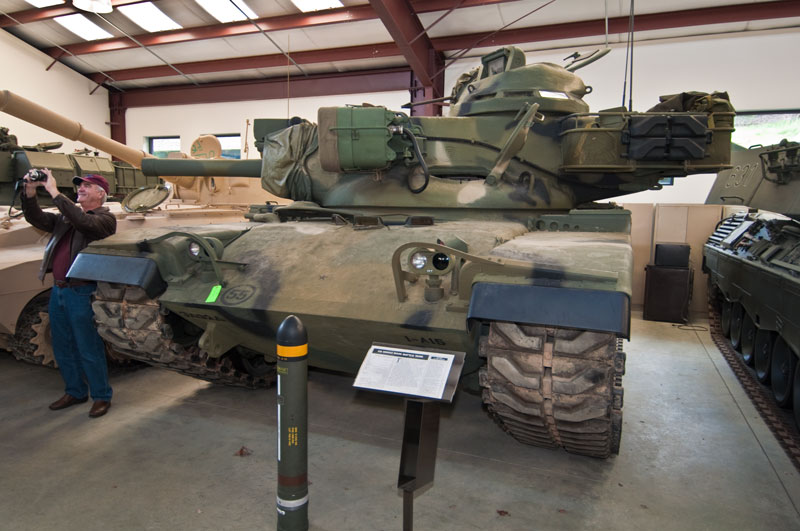
US M60A2 Starship MBT. The M60A2 was nicknamed Starship due to its "space age" technology. It had a new low-profile turret (arguably ruined by the commander's machine gun cupola) and a 152mm main gun that could fire both conventional rounds as well as the Shillelagh anti-tank guided missile. This armament proved overly complex and difficult to maintain, and most M60A2s were rebuilt as M60A3s with the M68 105mm gun. Many of the technological innovations that gave the M60A2 its nickname were later used in the design of the M1 Abrams MBT, the current US MBT. The M60A2 had a crew of 4, and weighed 49 tonnes.
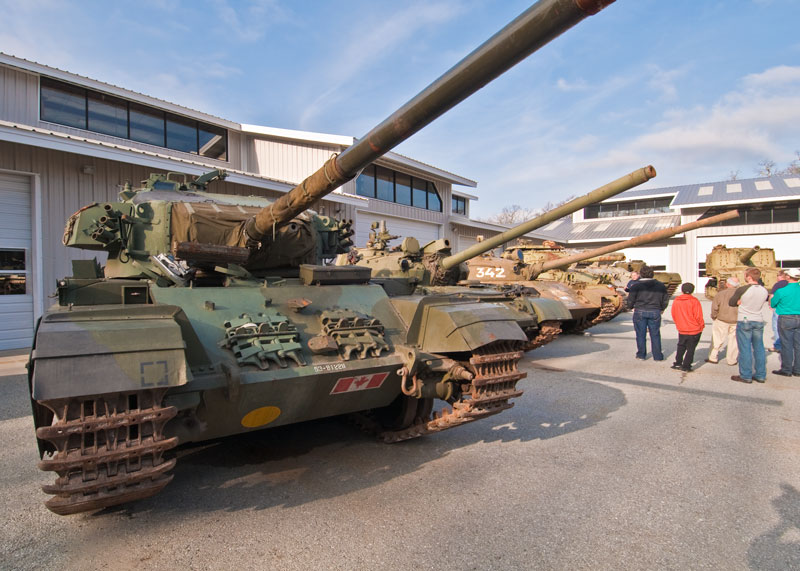
British Centurion Mk. 5 MBT. The Centurion was the primary British MBT of the post-WW2 era. Introduced in 1945, it first saw combat with the British army in Korea and, in subsequent revisions, served in the Indo-Pakistani wars of 1965 and 1971, Vietnam, the Arab-Israeli wars of 1967 and 1973, and the 1975 and 1982 Israeli invasions of Lebanon. Some remain in service today. The Centurion was the first British tank to combine the attributes of the infantry and cruiser-type tanks, the essence of the MBT concept. The Centurion Mk 5, shown here, has a 20 pounder (84mm) gun that could fire an armor-piercing discarding sabot (APDS) round at a muzzle velocity of 4,800 feet/sec. Later versions were upgunned to the L7 105mm gun. The Centurion had a 4 man crew. Weight was 52 tonnes.
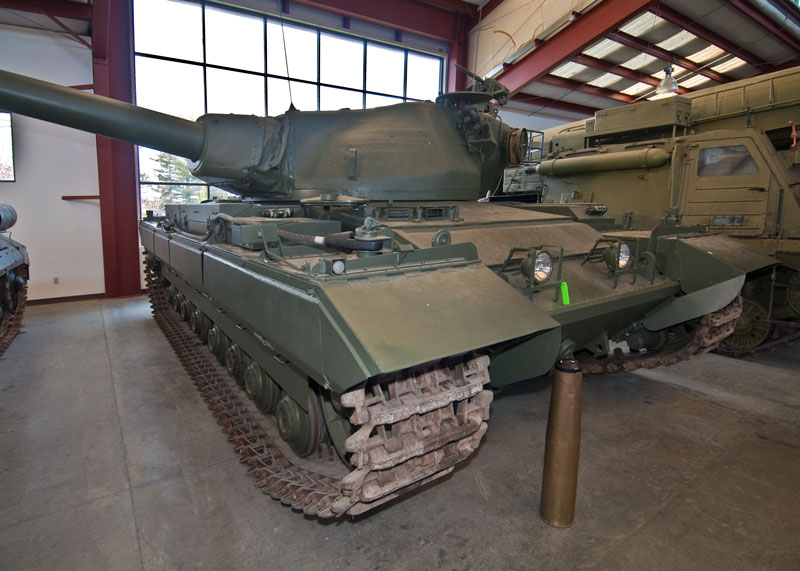
British Conqueror Mk. 1 Heavy Tank. The Conqueror was the primary heavy British Heavy Tank of the post-WW2 era, and like the US M103 Heavy Tank (above) was developed to match the heavy Soviet tanks of the early Cold War. The Conqueror's main armament was the same US 120mm M58 rifled gun used on the M103, and like the M103 the Conqueror proved to be too heavy and difficult to transport. Contemporaneous with the more successful Centurion MBT (immediately above), development was slow and production did not begin until 1955 and ended in 1959. The Conqueror had a crew of 4 and weighed 66 tonnes.
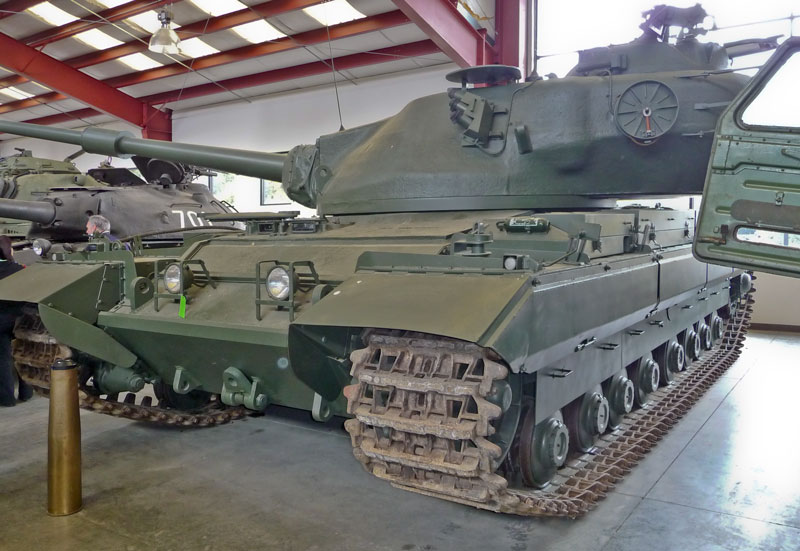
British Conqueror Mk. 1 Heavy Tank, another view from the right side that shows the huge turret more clearly. Note the huge shell casing, almost 35" in length, standing in front of the tank, of the M58 gun that would have piled up in the turret as the gun was fired. (Photo by Jon Miller.)
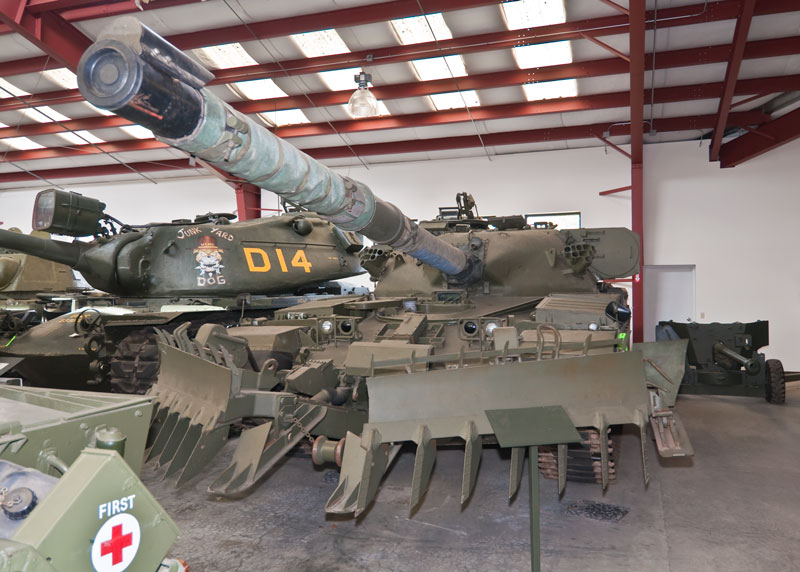
British Chieftain Mk. 6 MBT (with bulldozer blade attachment). The Chieftan was introduced in 1966, replacing the Centurion MBT, and remained in service in the UK until 1995. During the 1960s and 1970s it was the arguably the most advanced MBT in the world. It was the first tank with a supine driver position that allowed for a very shallow front glacis angle of 72 degrees, and it was the first tank to mount Chobham composite armor, giving the Chieftain unparalleled armor protection. Main armament was the 120mm L11A5 L/55 rifled gun in which the projectile and propellant were loaded separately. The Chieftain had a crew of 4, and its weight was 56 tonnes.
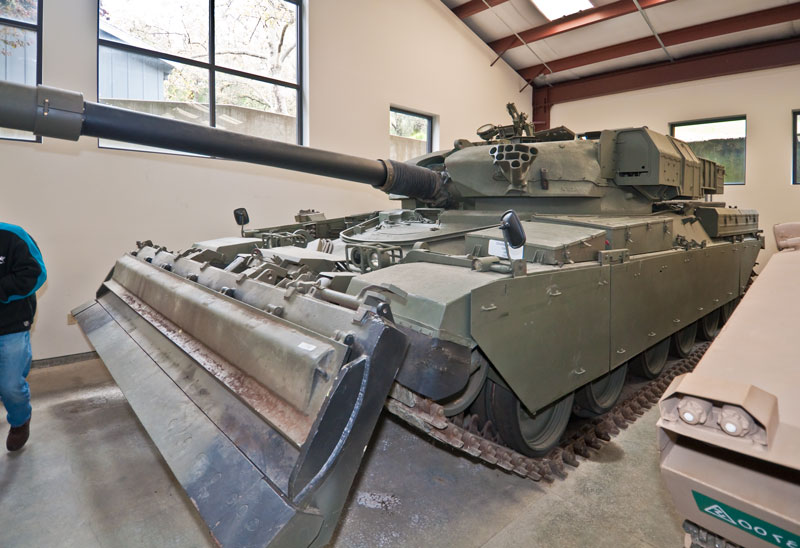
British Chieftain Mk. 13 MBT, with a bulldozer blade mounted for road clearing and creating defensive positions. A later revision of the Mk. 6 above.
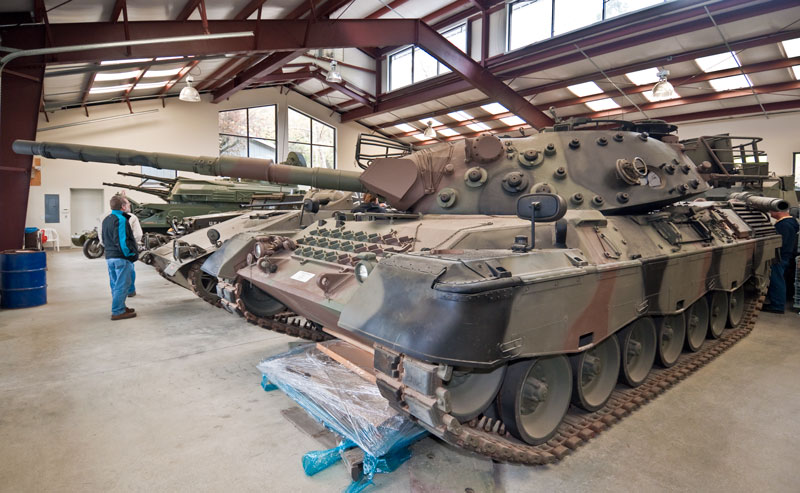
German Leopard 1A1 MBT. The Leopard first entered service in 1965, and subsequently was adopted as the MBT in many European nations, finally being retired in Germany in 2003, though it continues to serve in a reserve role. It mounts the British L7A3 L/52 105mm gun. This particular tank below appears to have applique spaced armor attached to the turret by bolts. Crew of 4. 40 tonnes.
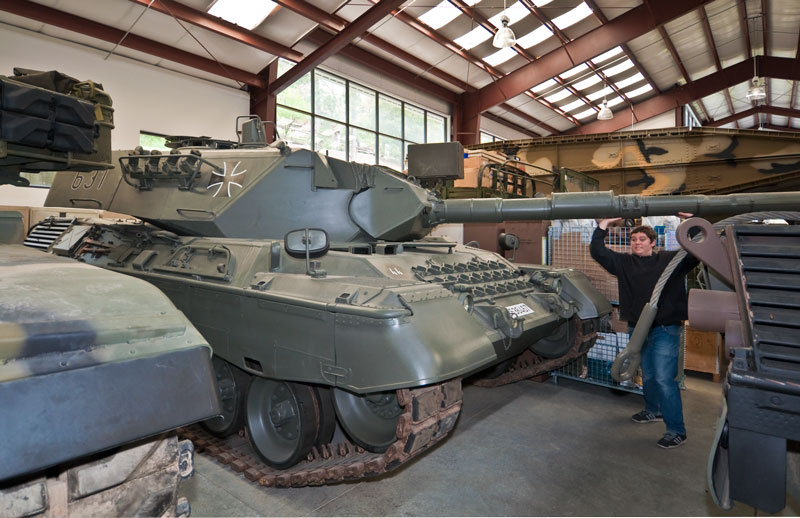
German Leopard 1A4 MBT. This was the final production version of the Leopard, introduced in 1974, that had a redesigned welded turret that incorporated spaced armor. Crew of 4. 42 tonnes. My nephew, Mark, is seen lifting the barrel. Though massive, the barrel can be quite easily moved due to its fine balance.
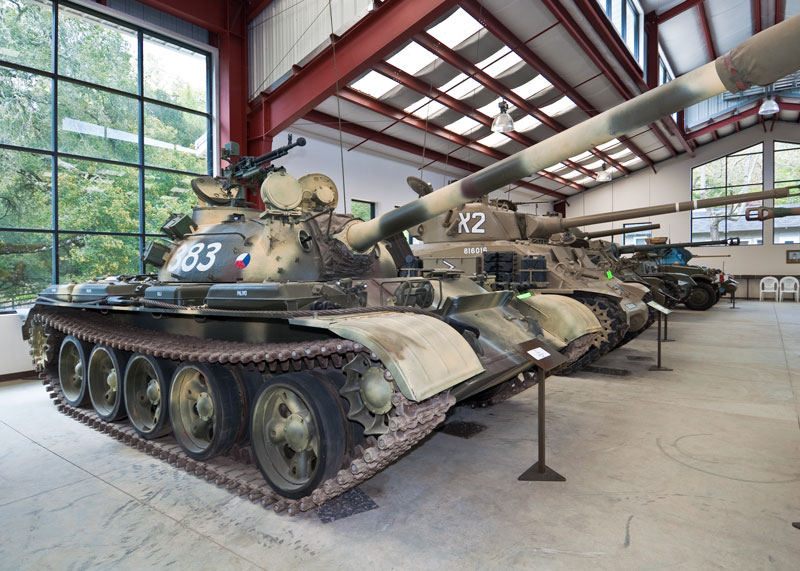
Soviet T-55 MBT. The T-55 was nearly identical in design to the T-54, from with it was derived, but for several notable upgrades: the addition of NBC protection (a new concern in the nuclear age), a revolving turret floor, and gun stabilization. It was produced from 1958-1983, first in the Soviet Union, then in Poland and Czechoslovakia, and saw service in the armies of all the Warsaw Pact Allies. Counting the T-54 that began production in 1947, up to an estimated 100,000 T-54/55 series tanks were manufactured, making the T54/55 the most produced tank in history. The T-55 remained in active service in the Soviet Union until the mid-70s, and still remains in many reserve units. The T-55 mounted a D-10T L/54 100mm rifled gun (muzzle velocity 3,300 ft/sec for an APHE round). Like the IS-3 Stalin Heavy Tank (above) it had a cast hemisherical turret that afforded excellent ballistic protection, but limited the gun depression to -5 degrees. The T-55 was robust and relatively small and light for a MBT, but its cramped interior negatively affected its crew's performance. Crew of 4. Weight of 40 tonnes.
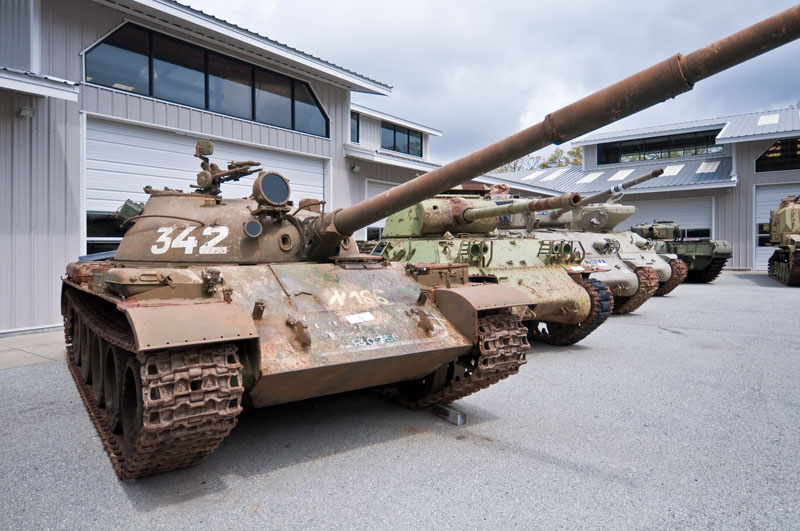
Soviet T-62 MBT. The T-62 was produced from 1962 until 1975, largely replacing the T-55 MBT. Like the T54/55, it saw service in all the Warsaw Pact countries. The T-62 mounted a 115mm 2A20 smoothbore gun, the first tank to do so, that required a larger turret than the T-55 could accomodate. The new 115mm gun was necessitated by the thicker armor of the contemporaneous US M48 and British Centurion tanks that were the T-62's presumed future opponents. The 115mm smoothbore gun could fire an armor-piercing fin-stabilized discarding-sabot round (APFSDS) at a muzzle velocity of 5,300 ft/sec. It had a 4 man crew, and weighed 40 tonnes.
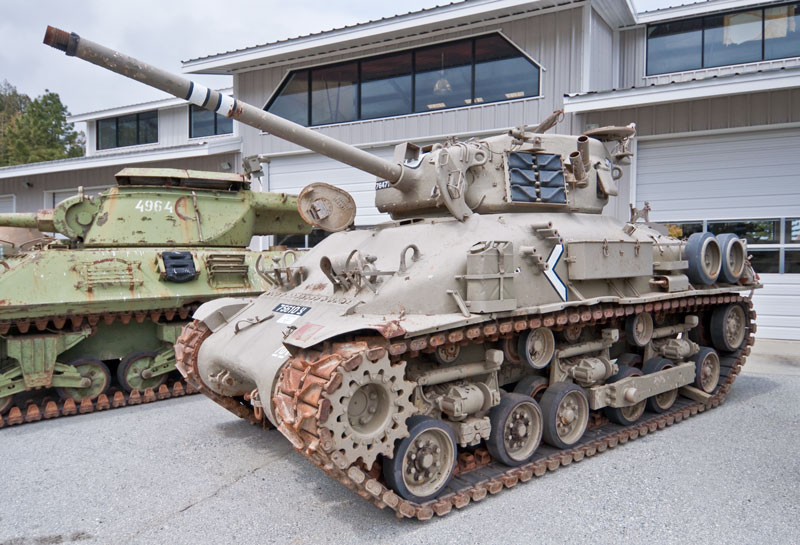
Israeli M1 Super Sherman. The M1 Super Sherman was the Israeli designation for the M4A1 Sherman with the 76mm gun and HVSS suspension. This vehicle was probably purchased by Israel from scrap at the end of WW2.
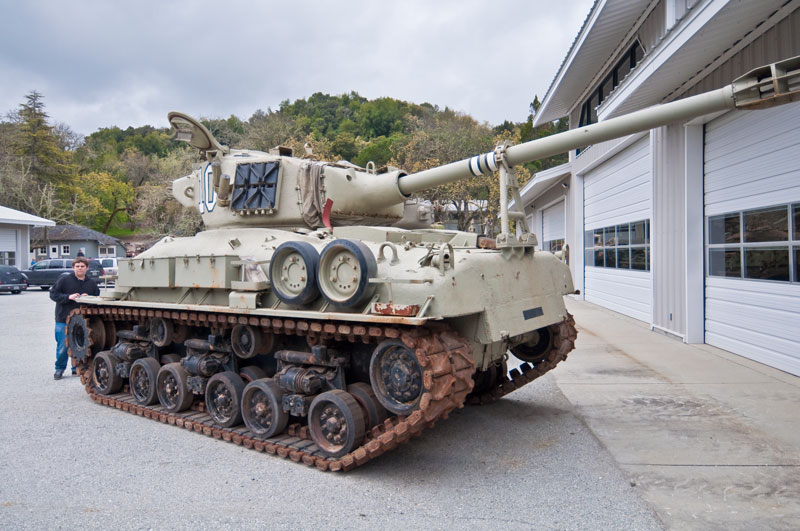
Israeli M51 Sherman (also called the "Isherman", a contraction of Israel and Sherman) Medium Tank. In the 1960s, Israel mated the French 105mm CN 105 F1 gun (shortened from L/56 to L/44) to an M4A1 HVSS chassis and turret to create the M51 below. This tank entered service in 1965 and fought in the Six Day and Yom Kippur Wars. It had a crew of 5, and weighed >33 tonnes.
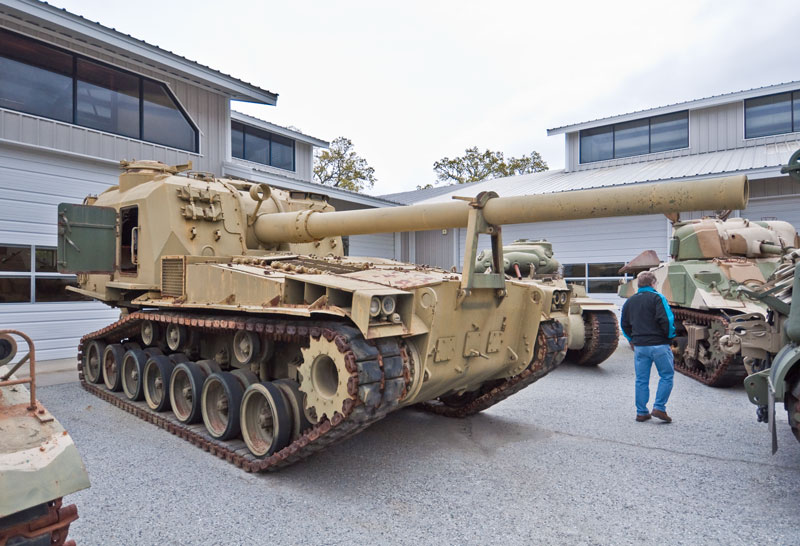
US M53 HMC. The M53 was a fully enclosed and armored self-propelled howitzer used by the US Armed Forces and its NATO allies during the 1950s and 1960s (the Marines continued to use it until the early-1970s), and it saw combat in Viet Nam. It was produced from 1952-1956. Its large turret could traverse +/- 30 degrees. Its main gun was a 155mm M46 howitzer. Crew of 6. Weight was 44 tonnes.
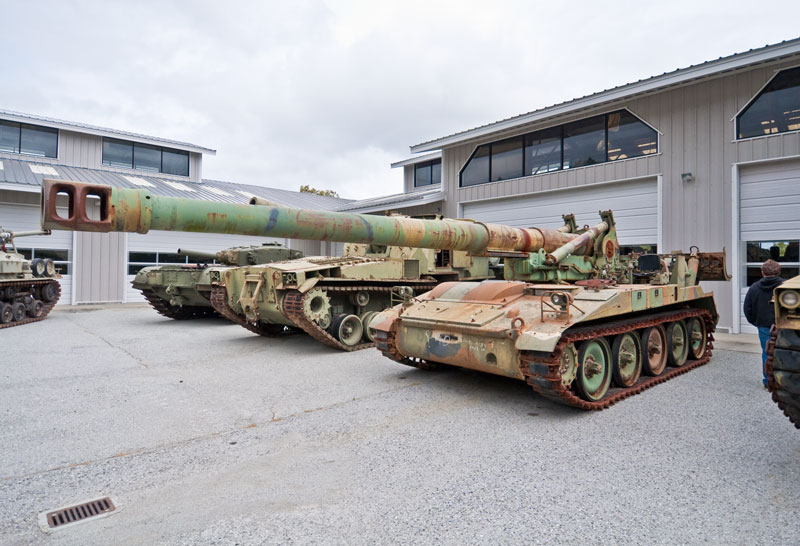
US M110A2 Self-Propelled Artillery. The 8-inch (203mm) M201A1 Howitzer was the largest mobile howitzer fielded by the US Army, beginning in 1963 and seeing service in the Viet Nam War and the Persian Gulf War of 1990/91. The M110 was phased out of service in the 1990s. The M110A2 differed from earlier versions by the addition of a double muzzle brake. It fired a 200-pound projectile at a muzzle velocity of 2,300 ft/sec that could travel more than 18 miles. It had a crew of 13, and weighed 28 tonnes.
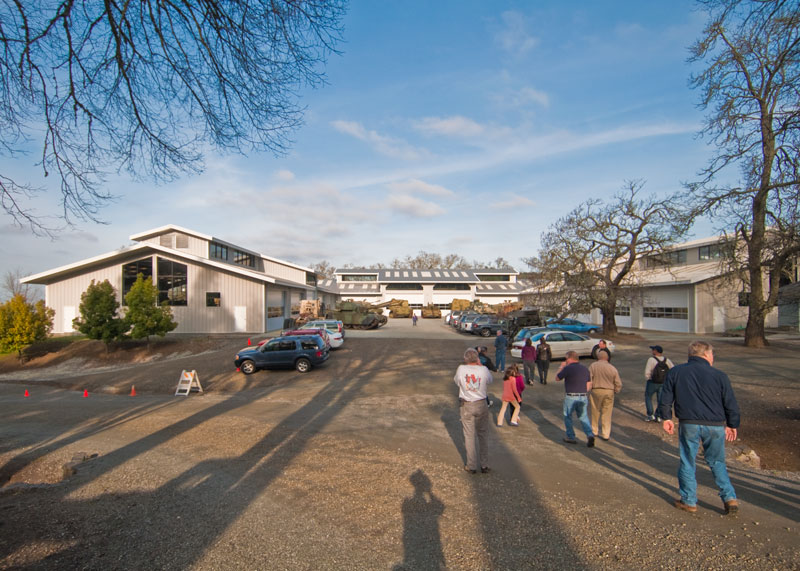
After three hours of military vehicle viewing in February, the exhausted tour group headed back to the parking area.
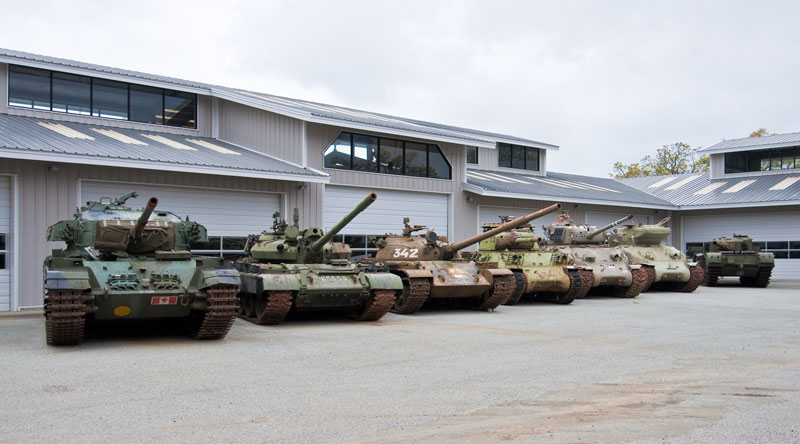
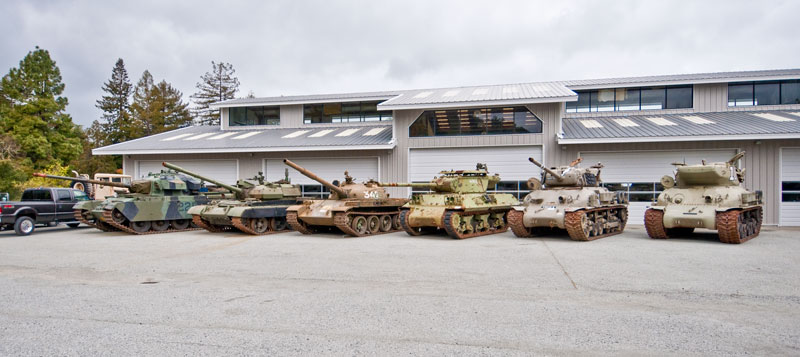
Above are two views of the tanks parked in front of the left-most building of the U. More detailed photos of most of these vehicles can be found above. From left to right are the British Centurion Mk. 5, Soviet T-55AM2, Soviet T-62, US M36B2, Israeli Super Sherman, Israeli M51 Sherman (turret reversed), and the British Churchill Mk. 7 AVRE. I didn't get photos of the T-55AM2 and the British Churchill Mk. 11, so I clearly have to return for a third visit to the MVTF!

US M88 "Haulin' Ass" ARV (Armor Recovery Vehicle). The M88 ARV was based on the M48 chassis and is still in current use by the US military. The M88 shown below is employed by the staff of the MVTF to move their vehicles around. Unfortunately, it appears to require some maintenance of its own. Weight is 56 tonnes.
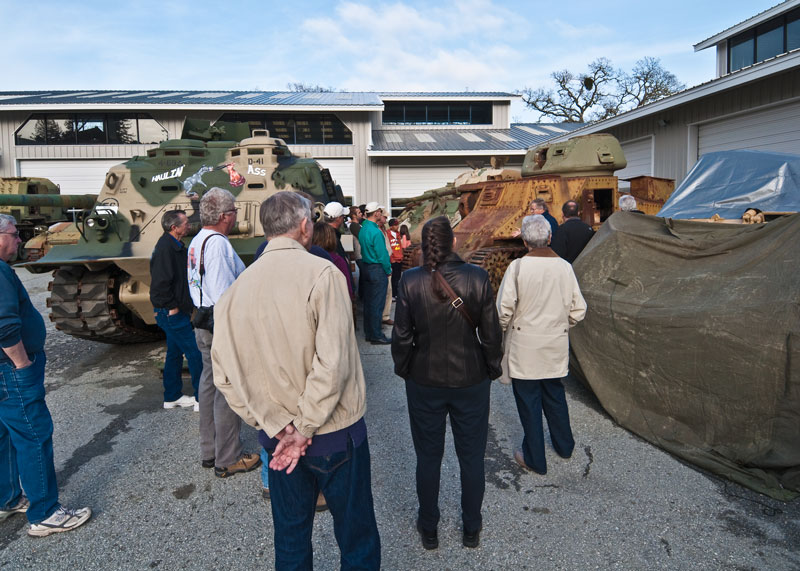
Here we're hearing closing remarks from our docent in February. He stands in front of a US/British M3A5 Grant Medium Tank to right of center (the one with the rusty hull and green turret). As noted above, the British removed the machine gun cupola and redesigned the turret of the M3 Lee to lower the tank's height, and renamed it the Grant. The M88 ARV is just behind the group in the center-left.
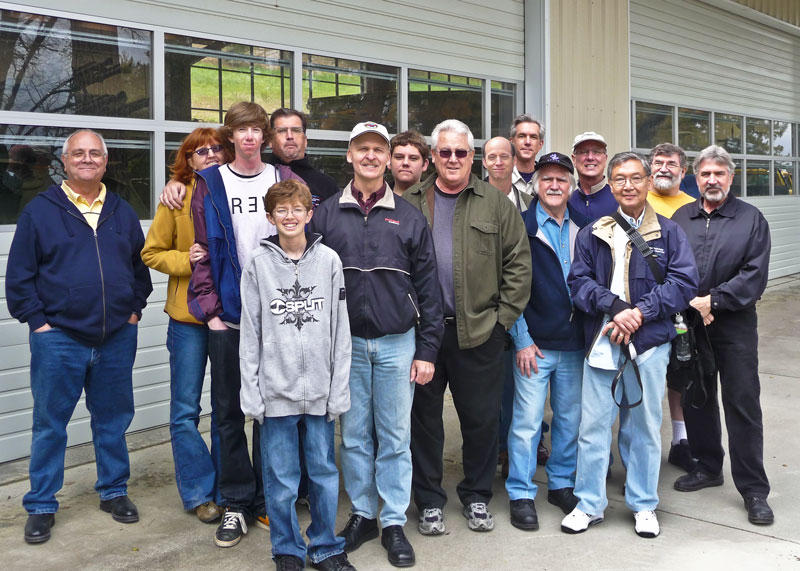
Here's our April group. Jon Miller, our organizer, is just left of center in the front in the dark jacket (standing with military bearing). I'm the tall thin guy in back towards the right. (Photo by our docent, Michael Brandt, using Jon's camera.) Unfortunately, we didn't get a group photo from February.
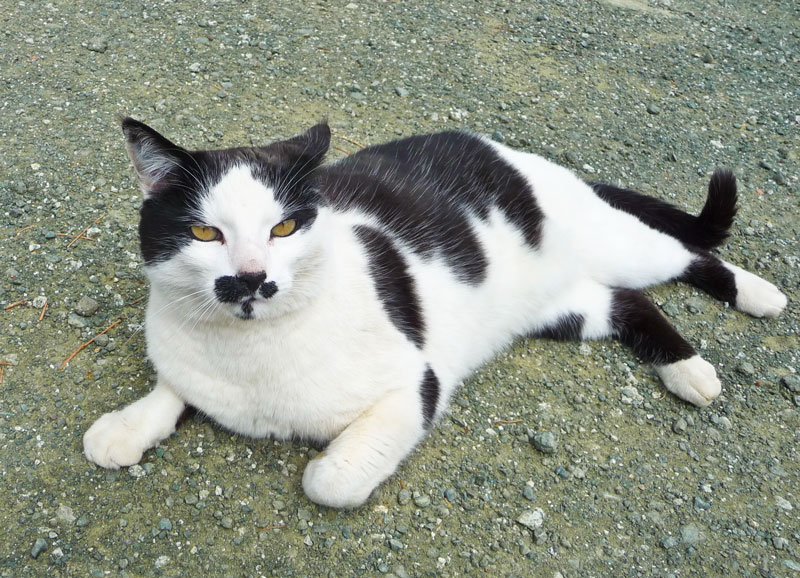
Here is our host, the resident cat, Hitler. You're already seen him perched on the back of the PzKpfw I Light Tank near the top of this page. He graciously kept us company throughout the tour. (Photo by Jon Miller.)
References:
First and foremost, the best information was supplied by our excellent docent, Michael Brandt.
Additionally, I used the following references from my own library:
- "British and American Tanks of World War II: The Complete Illustrated History of British, American and Commonwealth Tanks, 1939-1945", by Peter Chamberlain and Chris Ellis (1969)
- "Armored Thunderbolt: The U.S. Army Sherman in World War II", by Steven Zaloga (2008). This is the best book by far that I've read of the M4 Sherman, its predecessors going back to WW1, its successors and derivatives during WW2 (e.g. the M7 mobile howitzer, the M36 mobile anit-tank gun, and the M26 tank), and the military and political doctrines that shaped its design and operations.
- "German Tanks of World War II: The Complete Illustrated History of German Amoured Fighting Vehicles 1926-1946", by F.M. von Senger und Etterlin. The best book I've found on the German tanks of WW2 and their development.
- "US Tank Destroyers of World War Two", by Steven Zaloga (1985).
- "Modern Battle Tanks", edited by Duncan Crow (1978). This is an excellent but dated history of all the major MBTs of the world since WW2 though the mid-70s, including their development, contrasting countries' MVT doctrines, and their deployments.
- "The M48-M60 Series of Main Battle Tanks", by Robert J. Icks (1971).
- "M1 Abrams Main Battle Tank", by Michael Green (1992).
- "Russian Tanks, 1900-1970: The Complete Illustrated History of Soviet Armoured Theory and Design", by John Milsom (1975).
